Bulletin – November 2004 Statement on Monetary Policy
Download the complete Statement 510KB
The Australian economy has continued to perform well during 2004, maintaining a solid pace of expansion and low inflation. Business and consumer confidence are at high levels, and there has been some scaling back in the year to date of the excesses in the housing market that had threatened to disrupt the economy last year. The economy has benefited from a generally favourable international environment and rising commodity prices. The sharp rise in oil prices over recent months has emerged as a possible dampening factor for global growth, but the effects at this stage are difficult to predict.
For the international economy, the current year has been a period of further recovery, though growth has eased from its rapid pace earlier in the year. The recovery in the United States, now entering its fourth year, appears well entrenched. Business investment and consumer spending are continuing to expand strongly and business confidence remains relatively high. Employment is increasing at a steady pace, though not as rapidly as earlier in the year. Other parts of the global economy continue to experience generally strong conditions. In Japan, business surveys report that conditions improved further in the September quarter to be at around their best in a decade. The Chinese economy is expanding rapidly and has become an important driver of overall global growth. Despite a modest slowing since the start of the year, the Chinese authorities remain concerned that the economy is in an overheated condition, and this prompted a rise in official interest rates in October to supplement the earlier tightening in credit controls. Growth in the smaller east Asian economies has been strong over the past year, though the pace appears to have eased recently, while the euro area is continuing its gradual recovery.
An important feature of the current economic upswing is that it has been associated with broadly based increases in commodity prices. At the global level, attention has focused particularly on the rise in oil prices and the possible impact this might have on global economic performance. The rise in oil prices has been, to a significant degree, a consequence of global economic strength rather than of disruptions to supply, though supply factors have clearly also played a part. It is to be expected that the rise in oil prices will dampen growth of the global economy and boost consumer prices relative to what would otherwise have been the case, but the size of these effects will depend importantly on the extent to which the recent increases are sustained.
While the rise in oil prices this year has attracted the greatest attention, there have also been strong price increases for a wide range of other mineral commodities. The RBA base metals index, for example, has increased by almost 30 per cent in foreign currency terms over the past year, and there have been substantial increases in coal and iron ore prices. For a commodity exporter such as Australia this represents a significant boost to the terms of trade and is thus providing a stimulus to incomes and spending. As discussed below, rising commodity prices have also begun to put some upward pressure on prices more broadly.
Financial markets have generally taken the view that the negative impact of rising oil prices on global economic activity will more than outweigh any inflationary impact. Thus rising oil prices over recent months have resulted in falling bond yields and reduced expectations of monetary tightening. Yields on 10-year bonds in the US have fallen back to around 4 per cent, a decline of about 70 basis points since mid year, and similar movements have occurred in bond markets in other countries. This is an unusual development against the background of early-cycle rises in official interest rates. Rising oil prices have also contributed to a lacklustre performance by the US share market, which has shown little net change since the start of 2004 despite strong economic growth in the US. Reflecting the overall negative sentiment in US financial markets, the US dollar has resumed the depreciating trend that began in early 2002.
In Australia, while the yield curve has flattened in line with developments in international markets, other financial prices have suggested a more buoyant sentiment. In particular, the Australian share market remains very strong, significantly outperforming those in other countries this year, and the Australian dollar has risen substantially over recent months. A common theme affecting both the share market and the exchange rate has been the strength in global commodity markets. Other economies with heavy exposures to commodities – Canada, New Zealand and South Africa – are also doing well and their currencies have also risen more than most against the US dollar.
The most recent economic data in Australia indicate that the economy is continuing to perform strongly. Business surveys have generally reported above-average conditions in the September quarter, in some cases suggesting that conditions were close to their best in a decade. Similarly, consumer confidence has been at near-record levels for the past four months. Retail sales figures, although unexpectedly soft in July and August, picked up in September, and it is likely that household spending is continuing to be boosted by the tax cuts and increased benefit payments announced in the May Budget.
Conditions in the labour market are also firm. Employment increased strongly in September, following some softer figures in the previous three months, with the unemployment rate remaining around 5½ per cent. Looking through the recent monthly volatility, labour market conditions continue to reflect a strongly growing economy, with employment having grown by 2.5 per cent over the past year. The bulk of this increase has been accounted for by full-time jobs. Prospects for further employment growth appear to be good, with business surveys suggesting that hiring intentions are at high levels.
The overall growth of the economy has remained highly dependent on domestic demand, with the expected recovery in exports slow to develop. While rural and services exports have picked up over the past year, capacity constraints have continued to hamper exports from the resources sector. However, strong growth in investment in that sector over the past couple of years should see significant additional productive capacity starting to come on stream over the year ahead. At the same time, as noted above, the economy is benefiting from sharp increases in commodity export prices, and this has contributed to the growth in domestic incomes and spending.
Inflation in Australia remains relatively low, though signs of upward pressure are now beginning to emerge in some areas. CPI inflation was 2.3 per cent over the year to the September quarter, down marginally from the previous quarter, with most underlying measures running slightly below the headline figure. In addition, despite reports of shortages of labour, aggregate wages growth remains under control at this stage. Over the past couple of years, the trend in underlying inflation has been one of gradual decline, reflecting the lagged impact of the exchange rate appreciation that took place during 2002 and 2003. However, this trend appears now to have largely run its course, and underlying inflation is likely to start rising next year as the impact of the earlier appreciation fades. Inflation in the non-tradables sector of the economy remains relatively high, though it has eased recently as a result of a slowing in housing construction costs. Producer price figures for the September quarter were higher than expected, with rising global commodity prices contributing significantly to upstream price increases.
Currently it is expected that underlying inflation will rise gradually to around 2½ per cent by the end of 2005 and slightly higher by mid 2006. Headline CPI inflation will remain higher than underlying measures in the coming year, reflecting the effect of higher petrol prices. While this outlook is similar to that presented in the August Statement, it is apparent that the trough in inflation will not be as low as had been expected at the beginning of the year, when both headline and underlying measures had been forecast to decline to a trough of 1½ per cent by the end of this year. In part this upward revision has reflected the lower exchange rate prevailing over much of the period since then.
Developments in credit and housing markets point to a continuation of the adjustment apparent since the early part of the year. Available data for house prices in the September quarter have again indicated flat or declining prices in most cities and at the national aggregate level. The adjustment to date has been an orderly one, so that the risk of an uncomfortably sharp decline in house prices does not appear to be large, though equally there does not appear much risk of a renewed upsurge at present. In addition to this adjustment occurring in the housing market, there has been a welcome slowing in household credit in recent months, following the earlier declines in loan approvals.
In summary, then, the information becoming available over recent months has continued to indicate a favourable combination of circumstances for the Australian economy. In particular, while business conditions have remained strong, inflation declined further in the September quarter and wage increases at an aggregate level have been well contained. Although financial conditions remain moderately accommodative, the excesses in house price inflation and household borrowing that were apparent last year have been reduced, with a consequent easing of the risk of disruption to the economy from those sources. In these circumstances the Board did not see a case for monetary policy to be tightened when it reviewed the policy setting at its three most recent monthly meetings. In light of the economic data becoming available during this period, the Board's decisions to hold the cash rate unchanged were well anticipated and provoked no reaction in financial markets.
Looking ahead, the international economic environment is likely to remain supportive of growth in Australia, with the global recovery well established and strong commodity prices providing a firm underpinning to the Australian economy. Although inflation in Australia is relatively low at present, it is expected to begin rising gradually next year, and the recent strength in upstream price pressures is consistent with this outlook. Accordingly, while there is no pressing need for higher interest rates at this stage, it continues to appear likely that the economy will require higher interest rates at some stage of the current expansion. The Board will continue to monitor developments and to make such adjustments to policy as may be required to promote sustainable growth of the economy with low inflation.
International Economic Developments
Conditions in the international economy remain generally favourable, and growth is becoming more broad-based geographically. The global expansion is continuing, although the pace of growth has moderated from the very rapid rates seen in the second half of 2003 and start of 2004. This has been most evident in the United States and Japan. The economies of east Asia continue to enjoy strong growth and the recovery in the euro area has become more firmly established. Strong growth is also evident in the emerging economies of Latin America and eastern Europe. Oil prices are at high levels, but this has not yet prompted any significant revisions to growth forecasts. In its latest assessment of the international outlook, the IMF forecasts that world GDP will grow by 5.0 per cent in 2004, which would be the fastest rate of growth in nearly 30 years (Graph 1, Table 1). World GDP growth is then expected to ease to 4.3 per cent in 2005, largely reflecting the return to more normal rates of growth in the US and Japan. Persistently high world oil prices would, however, be likely to see downward revisions to growth forecasts for 2005.
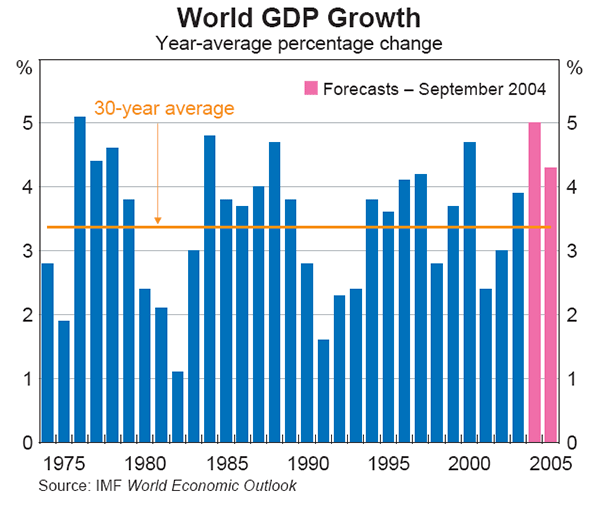
| 2002 | 2003 | 2004 | 2005 | |
|---|---|---|---|---|
| IMF Forecasts (September 2004) | ||||
| United States | 1.9 | 3.0 | 4.3 | 3.5 |
| Euro area(b) | 0.8 | 0.5 | 2.2 | 2.2 |
| Japan | −0.3 | 2.5 | 4.4 | 2.3 |
| China | 8.3 | 9.3 | 9.0 | 7.5 |
| Other east Asia(b) | 4.7 | 3.7 | 5.6 | 4.5 |
| G7 | 1.2 | 2.2 | 3.7 | 2.9 |
| Australia's major trading partners(c) |
2.8 | 3.5 | 5.0 | 3.7 |
| World | 3.0 | 3.9 | 5.0 | 4.3 |
|
(a) Aggregates weighted by GDP at PPP exchange rates unless otherwise specified
Sources: CEIC; IMF; RBA; Thomson Financial |
||||
In light of this strong global growth, central banks around the world have continued the process of removing some of their earlier policy stimulus. The Federal Reserve, the Bank of England, Bank of Canada and a number of other central banks have lifted their policy rates in the past three months. The European Central Bank and Bank of Japan have again been notable exceptions, leaving rates unchanged in response to the more modest recovery underway in those countries.
United States
After experiencing a patch of softer growth around mid year, the US economy has picked up in recent months. Real GDP grew by 0.9 per cent in the September quarter to be 3.9 per cent higher in year-ended terms (Graph 2). The stronger September quarter result largely reflected a rebound in consumption growth after a lull in the June quarter; business investment continues to expand strongly.
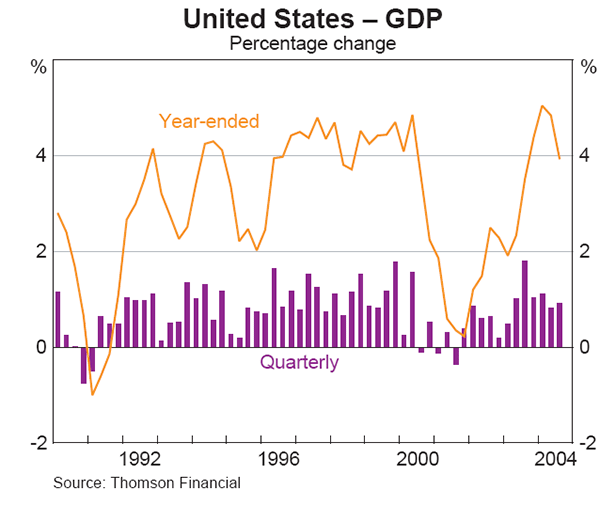
Recent employment data have generally been disappointing, but most other indicators point to a brighter outlook for the labour market. Non-farm payrolls have posted only modest gains since June, after rising strongly in the first five months of the year (Graph 3). The string of hurricanes that hit the US in August and September appears to have had a temporary downward influence on payrolls. The unemployment rate has declined from a peak of 6.3 per cent in mid 2003 to 5.4 per cent in September, but this decline can be partly attributed to a falling participation rate. Other indicators of the labour market are generally quite positive, consistent with the healthy pace of GDP growth. Initial jobless claims are running at around 340,000 per week – a level usually commensurate with monthly payroll gains of roughly 150,000–200,000. Strong growth in temporary-help services jobs, which in the past has been a reliable predictor of payroll employment, suggests near-term increases in employment of a similar magnitude in coming months. The employment indices from both the manufacturing and non-manufacturing ISM surveys are at high levels, which would normally be consistent with monthly payroll gains of around 200,000, or a little above.
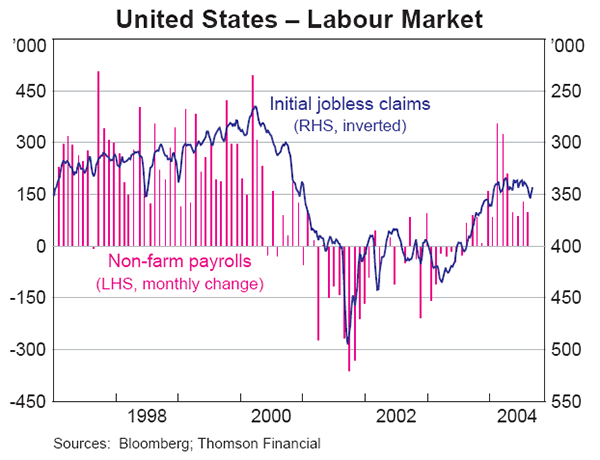
Consumption grew by 1.1 per cent in the September quarter, up from the 0.4 per cent growth recorded in the June quarter, to be 3.5 per cent higher over the year. Growth in household net wealth slowed slightly over the June quarter, but over the year it has been a strong 11 per cent. The recovery in employment should underpin further solid growth in household spending. Against this, consumer sentiment has recently weakened, possibly due to the run-up in oil prices, after having registered solid gains over the year to mid 2004. Following strong activity in the housing sector in recent years, growth in residential investment slowed in the September quarter, but it remains around 8½ per cent higher over the year, supported by low long-term fixed mortgage rates. Leading indicators of activity, such as housing starts and approvals, appear to have reached a plateau, although builders' confidence is at a high level.
Conditions in the business sector remain positive. The manufacturing and non-manufacturing ISM indices have come off their recent highs, but remain at expansionary levels (Graph 4). Business investment grew by 2.8 per cent in the September quarter, to be up by nearly 10 per cent over the year. The growth over the past year has largely reflected increased equipment investment, although non-residential construction investment grew for the second successive quarter, after declining for much of the previous few years. Core capital goods orders, which are a timely indicator of equipment investment, are growing at an annual pace of around 10 per cent. Financing conditions remain very supportive of investment growth; in particular, corporate profits grew by 19 per cent over the year to the June quarter and are quite high relative to GDP. Corporate gearing continues to decline and interest rates for corporate borrowing remain very low, even though the Fed funds rate is now rising. Firms may also be bringing forward some capital spending in order to take advantage of accelerated depreciation allowances that expire at the end of the year.
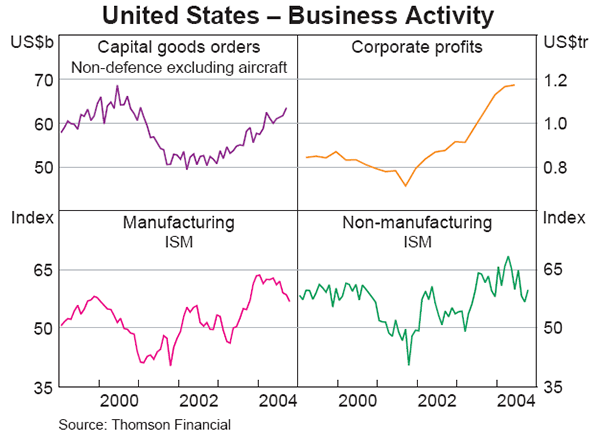
After a noticeable pick-up in inflationary pressures in the first five months of the year, core CPI inflation has been a little more subdued recently, and was 2.0 per cent over the year to September. The effect of crude oil price increases on headline inflation has been surprisingly modest in recent months, with year-ended headline inflation actually easing from 3.3 per cent in June to 2.5 per cent in September. There are still signs of significant upstream price pressures; the prices-paid indices from both of the ISM surveys are at high levels. With the US economy firmly on an expansionary path, the Federal Reserve has continued the process of returning interest rates to more normal levels, raising the funds rate by 25 basis points in both August and September to 1.75 per cent.
Asia-Pacific
Japan
The Japanese economy continues to recover, though growth has moderated from the rapid pace recorded around the start of the year. Following two very strong quarters, real GDP expanded by 0.3 per cent in the June quarter, to be 4.3 per cent higher over the year. The extent of the fall in the deflator is probably overstated, which might be boosting measured real GDP; nominal GDP grew by a more modest 1.4 per cent over the year to the June quarter (Graph 5).
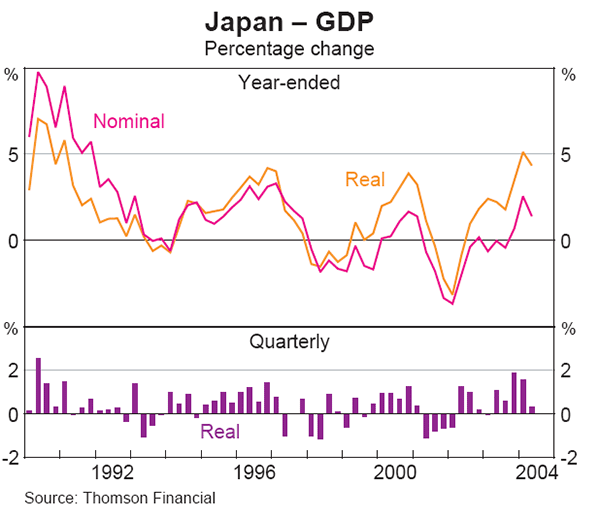
Having made significant progress in mending its balance sheet, the Japanese corporate sector appears in much better health than it has been in for many years. Corporate profits rose by 6.5 per cent in the June quarter and by 33 per cent over the year. This healthy cash flow points to further strength in investment (Graph 6). It has also enabled firms to repay their outstanding debts, with corporate debt (as a share of GDP) falling to levels not seen since the late 1980s. Consistent with this, business conditions, as reported by the Tankan and Shoko Chukin surveys, have improved to decade-high levels, with the manufacturing sector generally outperforming the services sector. On the other hand, indicators of corporate activity such as industrial production, machinery orders and merchandise exports point to some easing of growth since the start of the year. Much of this can be attributed to developments in the ITC sector, where inventories have risen significantly in recent months, suggesting the beginnings of a downturn in the sector.
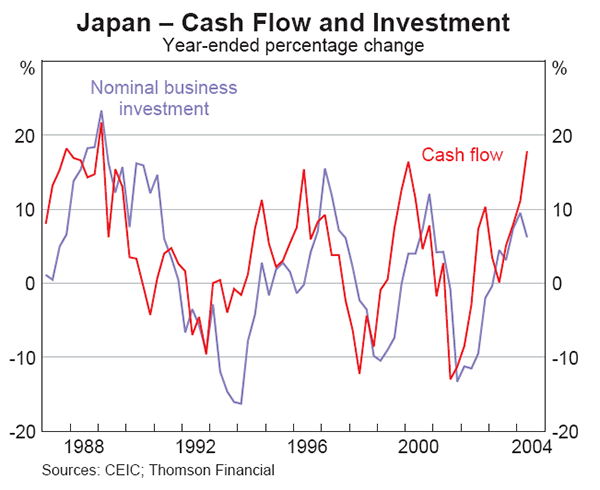
The outlook for the labour market remains relatively upbeat. Despite some recent volatility, the unemployment rate has been on a downward trend and stood at 4.6 per cent in September, down from 5½ per cent in early 2003. A shrinking labour force, associated with an aging population, has driven some of the fall, but employment has also picked up over the past year, as reported in both the household and payrolls surveys. Forward-looking indicators, such as surveyed hiring intentions and the ratio of job offers to applicants, also point to further gains in the near term.
Data on the household sector have been more mixed, but on balance remain positive. With employment prospects improving, consumer sentiment has risen to its highest level since the early 1990s, while indicators of consumer spending, such as retail sales and consumer goods shipments, have generally been trending upwards in recent months. However, cash wage earnings continue to fall in year-ended terms, held down partly by fairly weak summer bonuses, and weigh on the outlook for household spending.
Consistent with the upswing in activity, deflationary pressures continue to ease, though falling prices are likely to persist for some time yet as there remains considerable spare capacity in the economy. Core consumer prices were flat over the year to September, compared with deflation rates of around 1 per cent in the past few years. Reflecting the run-up in world commodity prices, domestic corporate goods prices have increased by 1.8 per cent over the year to September – the fastest rate of increase since 1991.
China
There has been a modest slowing in growth in the Chinese economy in recent months as government measures aimed at curbing over-investment in certain sectors and reducing credit and money growth have taken effect. The authorities tightened monetary policy in late October, on concerns that investment growth is still very strong. Growth in China continues to run well ahead of that seen in most other countries.
Compared with year-ended rates in excess of 9½ per cent in recent quarters, China's real GDP rose by 9.1 per cent over the year to the September quarter. The slowdown was most pronounced in the sectors that have been targeted by the authorities. Growth in fixed-asset investment came down to around 28 per cent over the year to September, from more than 50 per cent at the start of the year. Growth in credit and the money supply has also slowed roughly in line with the official targets for 2004. In contrast, there has been only a gentle slowing in growth in industrial production, which eased to 16.1 per cent over the year to September from a peak of 19.4 per cent in March (Graph 7). Growth in trade has also moderated over recent months, but remains strong. The value of merchandise exports increased by around 33 per cent over the year to September, with imports 21 per cent higher over the same period. Household expenditure remains buoyant, with retail sales continuing to grow rapidly, underpinned by rising per capita incomes.
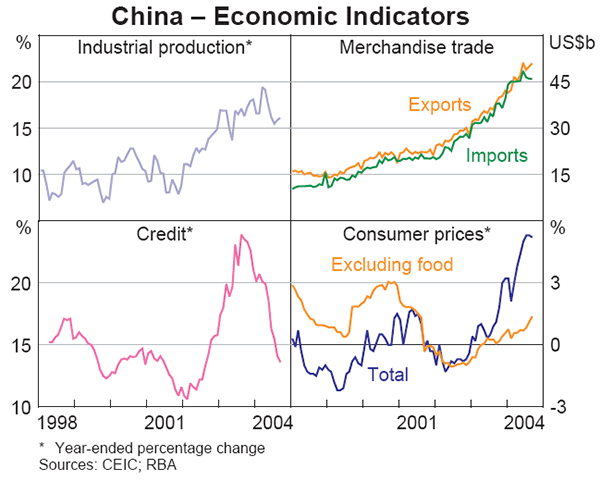
Consumer price inflation has risen, to 5.2 per cent over the year to September, close to its highest rate in over seven years. Food prices continue to be the main driver of inflation, rising by 13 per cent over the year to September, but this upward pressure appears to be easing as domestic supply expands. Excluding food, consumer prices generally remain contained, though some pressure on housing costs has emerged recently; this component of the CPI was 6.4 per cent higher over the year to September.
Other Asia-Pacific
Growth in the rest of east Asia has also slowed somewhat from its earlier rapid pace, although it remains reasonably firm. In aggregate, GDP increased by a little more than 7 per cent over the year to June, although this figure was boosted by the rebound from the SARS-related weakness mid last year. In the quarter, growth eased in line with developments elsewhere in the world (Table 2). Domestic demand is picking up in most countries in the region, underpinned by improving labour markets and still-stimulatory macroeconomic policies. Korea is still an exception, with domestic demand remaining weak amid little sign of a turnaround in household consumption. High oil prices are likely to weigh on growth in east Asia more than elsewhere, because its economy is a relatively intense user of oil, almost all of which is imported. Of course, strong growth in east Asia has also been one of the key factors pushing up oil prices.
| March quarter 2004 |
June quarter 2004 |
September quarter 2004 |
Year to latest quarter |
|
|---|---|---|---|---|
| China | 4.0(a) | 0.4(a) | 2.6(a) | 9.1 |
| Hong Kong | 1.2 | 2.6 | – | 12.4 |
| India | 0.6 | 1.2 | – | 7.3 |
| Indonesia | 2.5 | 0.4 | – | 4.2 |
| Korea | 0.7 | 0.6 | – | 5.8 |
| Malaysia | 1.7 | 1.8 | – | 8.0 |
| Philippines | 2.2 | 0.7 | – | 6.0 |
| Singapore | 2.7 | 2.9 | −0.6 | 7.8 |
| Taiwan | 1.3 | −0.6 | – | 7.8 |
| Thailand | 0.8 | 0.8 | – | 6.3 |
|
(a) RBA estimates Sources: CEIC; RBA |
||||
Export growth slowed in the June quarter, and recent indicators suggest that this trend has continued. Annual growth in merchandise exports has slowed from 29 per cent over the year to May to 23 per cent over the year to September, and is expected to moderate further in conjunction with the easing in Chinese growth. In addition, signs are emerging that the global upswing in ITC demand, which has been a significant driver of the region's export growth, may have peaked. Industrial production has also levelled off recently, to be 8 per cent higher over the year to August, down from 14 per cent in May (Graph 8).
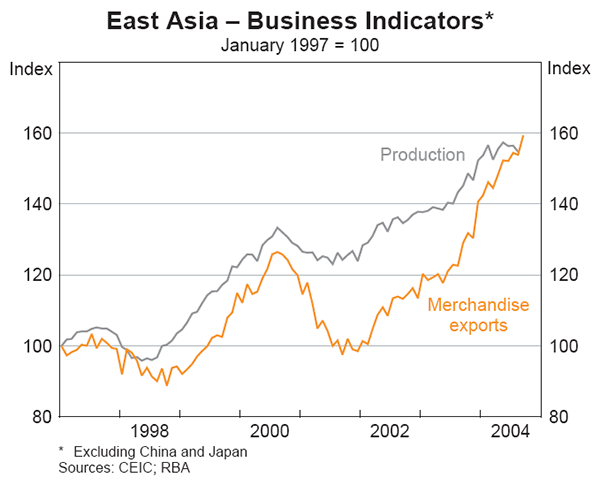
In contrast, the outlook for domestic demand remains favourable; interest rates are low, capacity utilisation rates are high and the labour markets in the region are improving. Activity in Taiwan and Hong Kong should also receive a boost from rising asset prices following a prolonged period of deflation. Korea is the main exception to this outlook; domestic activity continues to be constrained by weak consumption, which declined again in the June quarter – its third successive quarterly contraction – to be 0.6 per cent lower over the year and 2.9 per cent below its peak in late 2002. Korea's monthly retail and wholesale sales also show little sign of a pick-up, with the labour market worsening recently and consumer confidence remaining depressed.
There has been a noticeable increase in consumer price inflation across much of east Asia in recent months (Graph 9). This appears to be largely due to higher food and energy prices, with underlying measures of inflation showing more modest rates of increase. However, there are signs that upstream price pressures are building amidst strong economic growth, and most central banks in the region have tightened monetary policy. The Bank of Korea, in contrast, cut its policy rate by 25 basis points in August to 3.5 per cent in order to stimulate domestic activity.
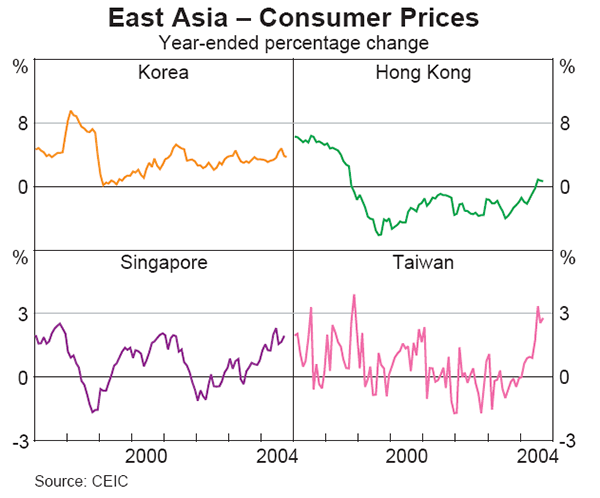
Growth in the Indian economy slowed in the first half of 2004 but remains healthy; over the year to the June quarter, real GDP increased by 7.3 per cent, down from more than 10 per cent over 2003. Industrial production continues to grow strongly, rising by 7.8 per cent over the year to August, and exports are up by 17.4 per cent over the year to September, although they have been broadly flat recently. A poor monsoon season is likely to constrain agricultural production in the period ahead. Inflation has increased noticeably in the past few months; the wholesale price index, the preferred inflation indicator in India, was up by 7.4 per cent over the year to September. In response, the Reserve Bank of India tightened monetary policy in late October.
Europe
The euro area recovery appears to be gaining momentum, although it is geographically uneven and still highly reliant on external demand. Euro area GDP grew by 0.5 per cent in the June quarter, to be 2.0 per cent higher over the year. The increase was almost entirely due to growth in net exports, with consumption and investment remaining weak. The stimulus to consumption from tax cuts at the beginning of the year appears not to have carried over into the June quarter. The share of investment in GDP has fallen to its lowest level in 15 years.
The pattern of growth varies considerably across euro area countries (Graph 10). Among the larger countries, France has been growing at the fastest pace, driven by strength in domestic demand and wealth effects from rising house prices. In Germany, Italy and the Netherlands, domestic demand remains sluggish and recent growth has been dependent on net exports. In Germany, consumer spending appears to have been restrained by uncertainty surrounding proposed welfare reforms, and investment remains weak despite a pick-up in corporate profitability. Germany's tight credit conditions may also be discouraging investment spending.
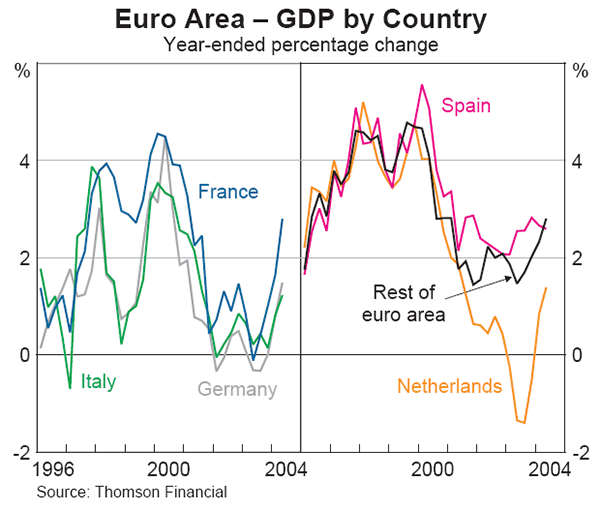
More timely indicators suggest that the euro area's modest recovery should continue. Extra-regional merchandise exports grew by 9.4 per cent over the year to August. On the back of this external demand, euro-wide industrial production has been growing fairly steadily, at an annual rate of around 2 per cent in recent months. Business sentiment in the area has continued to edge higher and is now above long-run average levels (Graph 11), although German business confidence has weakened recently on concerns about the continued lack of domestic demand.
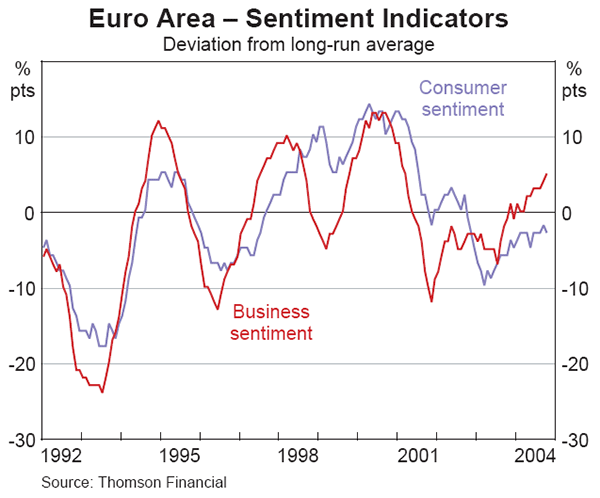
The recovery in consumer sentiment over the past year has been more modest, and sentiment remains below average levels. Lacklustre labour market outcomes and reform-related uncertainty have constrained confidence and spending. The euro-wide unemployment rate remains stubbornly high at 9.0 per cent and shows little sign of improvement in the near term. Retail sales have been broadly unchanged of late.
Continued upward pressure from energy prices has kept overall inflation above the ECB's 2 per cent reference rate since May, although underlying measures of inflation have remained around 2 per cent. The impact of energy prices has been more pronounced in producer price inflation, which climbed to 3.1 per cent over the year to August. Year-ended growth in labour costs has continued to ease, reaching 2.2 per cent over the year to the June quarter, consistent with the subdued labour market. The ECB has held its policy rate unchanged at 2 per cent since June 2003.
After growing at a stronger-than-expected 0.9 per cent in the June quarter, the UK's GDP expanded by a moderate 0.4 per cent in the September quarter, to be 3 per cent higher over the year. More recent data suggest slower growth than the above-trend pace of the past year. Merchandise exports were broadly flat in the three months to August, hampered by soft demand from the euro area. Manufacturing production fell in September for the third consecutive month, although this outcome was somewhat at odds with the relatively upbeat business surveys.
Consumer confidence is also high, and labour market conditions remain tight; according to the Labour Force Survey, the unemployment rate has fallen to an historically low 4.7 per cent. In the past few years consumer spending has received a significant fillip from rising house prices, but recent data suggest some cooling in the market. According to the Nationwide and Halifax surveys, there was a marked slowing in house price growth in the past three months, although prices remain well above levels of a year ago (Graph 12). The value of housing loan approvals has dropped sharply from its peak in September last year. Despite the strength of economic activity since the middle of 2003, inflation has remained well below the Bank of England's 2 per cent target, and was 1.1 per cent over the year to September. The Bank of England raised the repo rate by 25 basis points to 4.75 per cent in August.
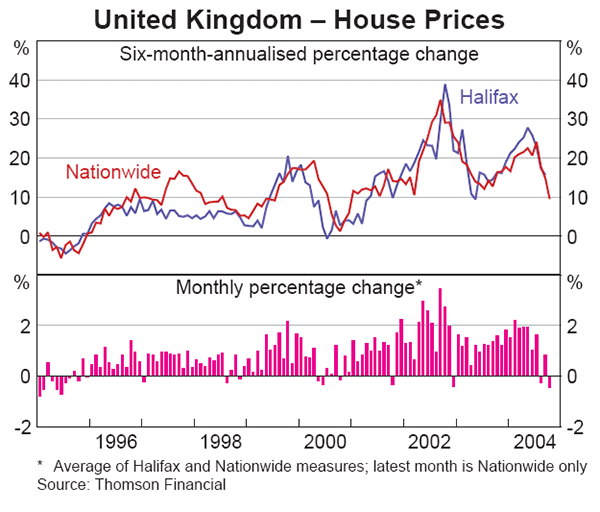
Oil price developments
Oil prices increased sharply over the three months to October, before reversing somewhat in early November. Global production capacity has continued to be stretched by strong demand, and short-term disruptions to supply have compounded the pressures on prices. Prices averaged just above US$53 per barrel in October, which is the highest nominal price on record, and around 75 per cent higher than a year earlier (Graph 13). However, in real terms they remain well below the levels observed following the second OPEC oil shock of late 1979, and the recent rate of increase has been much less pronounced than during that episode.
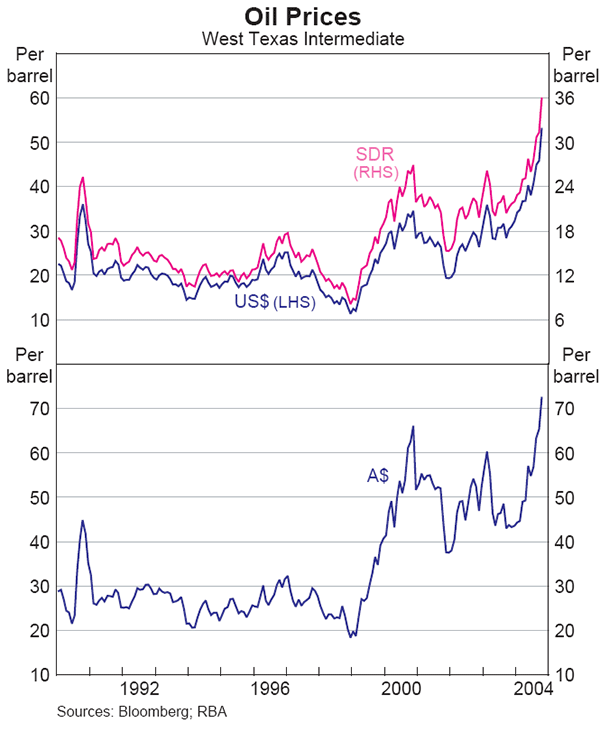
According to the International Energy Agency (IEA), expectations of oil demand in 2004 have been steadily revised up over the course of the year, to 82.4 million barrels per day (bpd), a 5.8 per cent increase in demand from two years ago. Global demand has been especially boosted by higher demand from China, which has risen by 1.3 million bpd, or 26 per cent over the past two years. With no similar expansion in global supply capacity, the amount of spare capacity has fallen to very low levels.
Potential and realised disruptions to short-term supply have exacerbated these trends, placing additional upward pressure on prices. Sabotage to oil infrastructure in Iraq has led to ongoing supply disruptions, while concerns remain over the outlook for production at Yukos, a Russian oil firm that is in danger of bankruptcy. Also, Hurricane Ivan recently disrupted production in the US, while labour unrest and threats from rebel militia have placed some doubt over the stability of oil supply from Nigeria. Some market analysts have estimated that these short-term supply problems, plus the current low level of commercial stocks of oil, have contributed to a risk premium of at least US$10 per barrel in prices.
International and Foreign Exchange Markets
Money markets
Many central banks around the world have begun the process of unwinding the very accommodative settings of monetary policy that have been in place over the past couple of years. The tightening process thus far has been very gradual, and two major central banks, the Bank of Japan and the European Central Bank, have yet to commence.
The US Federal Reserve has continued on the path begun in June, raising the federal funds rate by 25 basis points at each of its two meetings since the last Statement, to the current level of 1.75 per cent (Graph 14). Like the June move, the two most recent interest rate increases were widely anticipated and had little impact on financial markets. The federal funds futures market is expecting the Fed to raise rates by a further 25 basis points at the November meeting, before pausing in December. Beyond that, markets are expecting a slower pace of tightening, in part reflecting their assessment that the contractionary effect on growth of the large rise in oil prices will outweigh the inflationary impact in the medium term. Futures markets are currently pricing in only a further 50 basis points increase in the federal funds rate by mid 2005 which, if realised, would still leave short-term rates at an historically low level.
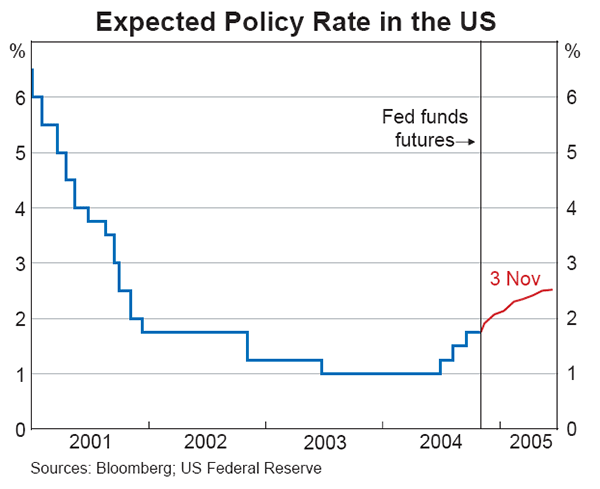
Financial markets still do not expect a shift in monetary policy in either the euro area or Japan until well into 2005. The European Central Bank has stated that it is comfortable that the economy is recovering gradually, although it is concerned about the effect of higher oil prices. The Bank of Japan's recently released inflation forecasts imply that an exit from its quantitative easing framework remains some way off given its position that this would occur only when inflation is consistently positive.
The Bank of England (BoE), Bank of Canada (BoC), Reserve Bank of New Zealand (RBNZ) and the Swiss National Bank (SNB) have all raised their policy rates over the past three months (Table 3, Graph 15). The two 25 basis point increases by the BoC have partially reversed a cumulative easing of 75 basis points at its first three meetings this year. The market's expectation is that the tightening cycle in both the UK and New Zealand is nearly complete, whereas both the BoC and the SNB are expected to tighten policy further over the coming year.
| Change in policy rates Basis points | |||
|---|---|---|---|
| From low point |
Since Jan 2004 |
Current level Per cent |
|
| New Zealand | 150 | 150 | 6.50 |
| Australia | 100 | – | 5.25 |
| UK | 125 | 100 | 4.75 |
| Canada | 50 | −25 | 2.50 |
| Sweden | – | −75 | 2.00 |
| Euro area | – | – | 2.00 |
| US | 75 | 75 | 1.75 |
| Switzerland | 50 | 50 | 0.75 |
| Japan | – | – | 0.00 |
|
Sources: central banks |
|||
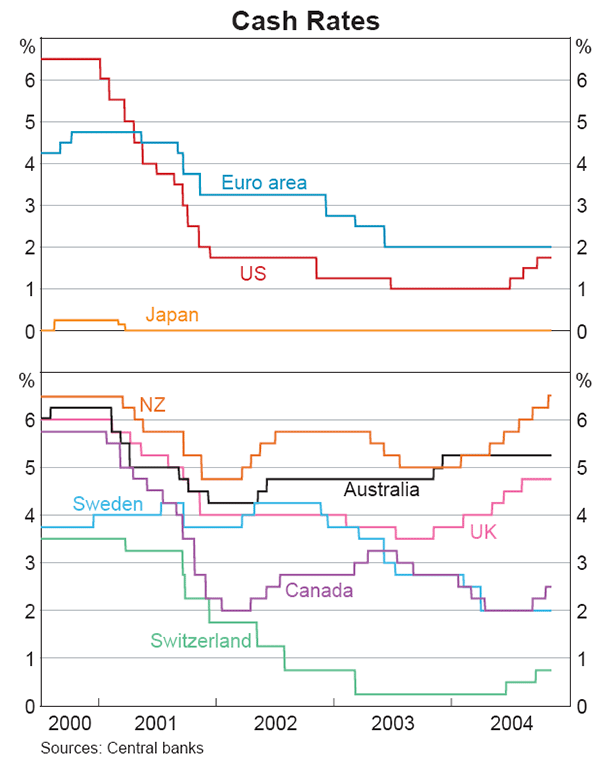
Monetary policy was also tightened in a number of emerging markets. In China, benchmark interest rates were raised and the ceiling on bank lending rates was also removed. These actions follow administrative tightening measures and increases in reserve requirements adopted over the past year. India, Thailand and Taiwan each increased interest rates for the first time in the current cycle, although policy rates in the latter two countries remain below 2 per cent. Short-term interest rates also increased in Hong Kong following the US tightenings, in line with Hong Kong's currency board arrangement. In contrast, the Bank of Korea surprised markets by lowering the overnight call rate by 25 basis points, to 3.5 per cent, in order to stimulate lacklustre domestic demand, notwithstanding the economy's ongoing inflation concerns.
Mounting inflationary pressures across Latin America prompted the central banks of Brazil, Chile, Mexico and Peru to tighten monetary policy. Among emerging European countries, the central banks of the Czech Republic, Poland and the Ukraine all increased their policy rates. In contrast, monetary policy was eased in Hungary and South Africa because of the impact of their appreciating exchange rates in terms of easing inflationary pressures. Turkey reduced rates by 200 basis points, reflecting growing confidence that inflation will continue to fall under a new IMF program.
Bond yields
Despite the 75 basis points increase in the federal funds rate, long-term bond yields in the US have declined steadily since mid year, falling back to around 4 per cent (Graph 16). The large rise in oil prices has had a marked influence on bond yields over the period. As mentioned above, the market is expecting the contractionary effect of oil price rises on growth to outweigh their inflationary effect, and hence increases in the oil price have tended to be associated with a decrease in yields over recent months. Indeed, the expected inflation rate derived from indexed bond yields has drifted lower over the past six months. The decline in bond yields has also been driven by a reduction in the expected pace of tightening over the coming year, in turn reflecting weaker-than-expected US employment data in recent months and the anticipated effect of the oil price rises.

Yields in Europe and Japan have closely followed those in the US over the past three months. Yields on German government 10-year debt have fallen around 50 basis points since their mid-June peak, while Japanese yields fell back to around the levels seen prior to the sharp increase in June.
The desire of investors to seek out higher yields in an environment of low funding costs, combined with a favourable economic climate globally, has seen risk spreads continue to decline. US corporate spreads to Treasury yields have narrowed modestly over recent months and have reversed the widening that occurred in May in anticipation of the Federal Reserve's tightening cycle (Graph 17). Given the relatively low level of Treasury yields, the absolute cost of corporate borrowing is at a very low level.

Spreads on emerging market sovereign debt have also continued to reverse the widening that occurred earlier in the year (Graph 18). The decline has been particularly marked in Latin America following credit rating upgrades for Brazil and Venezuela. Similarly, the narrowing in emerging Europe was supported by upgrades to the credit rating outlook for Russia and Poland, in the former case prompted in part by rising oil revenue. Spreads in Asia narrowed slightly.
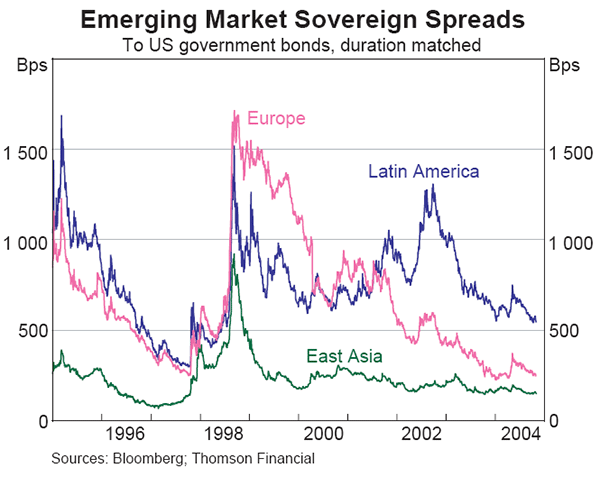
Equity markets
In the US, the S&P 500 is little changed so far this year, after the strong increases last year (Table 4). The recent lacklustre performance comes despite continued strong growth in company profits: S&P 500 operating earnings rose by 32 per cent in the year to the June quarter, while growth in ‘as reported’ earnings was even stronger, at 39 per cent.
| Change since 2000 peak |
Change since 2003 trough |
2004 to date |
|
|---|---|---|---|
| United States | |||
| – Dow Jones | −14 | 35 | −3 |
| – S&P 500 | −25 | 43 | 3 |
| – NASDAQ | −60 | 58 | 0 |
| Euro area | |||
| – STOXX | −45 | 56 | 6 |
| United Kingdom | |||
| – FTSE | −32 | 44 | 5 |
| Japan | |||
| – TOPIX | −38 | 42 | 5 |
| Canada | |||
| – TSE 300 | −22 | 42 | 8 |
| Australia | |||
| – ASX 200 | 14 | 42 | 16 |
|
Source: Bloomberg |
|||
High oil and commodity prices have boosted profits in the energy and materials sectors, which both recorded growth in operating earnings of around 70 per cent in the year to the June quarter. Shares in the energy sector have risen by 24 per cent this year (Table 5), but this sector accounts for only 7 per cent of the S&P 500. However, the net impact of high oil prices on the overall market has been negative. Along with some tempering of the optimism that prevailed earlier in the year about the growth outlook, rising oil prices have contributed to the expectation that profit growth will slow considerably in the period ahead. Only the industrials sector and the telecommunications sector – which was the only sector to record a fall in earnings in the year to June – are expected to register a modest improvement in profit growth over 2004.
| Sector | Since 2003 trough |
2004 to date |
|---|---|---|
| Consumer discretionary | 57 | 4 |
| Consumer staples | 22 | 1 |
| Energy | 54 | 24 |
| Financials | 48 | 2 |
| – Insurance | 40 | −3 |
| Health care | 13 | −5 |
| Industrials | 60 | 9 |
| Information technology | 47 | −4 |
| Materials | 60 | 3 |
| Telecommunications | 47 | 11 |
| Utilities | 53 | 13 |
| S&P 500 total | 43 | 3 |
|
Source: Thomson Financial |
||
In mid October, shares in the insurance industry fell by over 10 per cent as the New York Attorney General charged Marsh & McLennan, the largest insurance broker, with improper practices. Shares in the auto industry also declined sharply following poor earnings figures from General Motors (GM) and news of an investigation by the Securities and Exchange Commission into pension and health benefit accounting procedures at Ford and GM.
In the euro area, equity markets have risen by 7 per cent since the last Statement, and are up by a similar amount in 2004 to date. In Japan, on the other hand, the combination of higher oil prices and the unexpected downward revision to second quarter GDP have seen equities fall by 4 per cent over this period; however they remain 5 per cent higher in the year to date.
Emerging equity markets have outperformed those in the major economies in recent months, with share prices in both Latin America and emerging Asia rising by an average of around 11 per cent since early August. South Korean share prices have risen by 18 per cent in response to the Bank of Korea's decision to lower interest rates to boost domestic demand. Indonesian equities rose by 17 per cent over the past three months, supported by the election of the new President. The equity market in Argentina has experienced the strongest gains in Latin America in recent months, rising by 31 per cent following the Argentine government's recent agreement to reschedule some of its defaulted debt, but this follows a decline of around 35 per cent earlier in the year.
Exchange rates
For much of the past three months, there was little to provide clear direction for foreign exchange markets, and the US dollar traded within a narrow range of 109 to 112 against the yen and around 1.20 to 1.25 against the euro. However, since late October, it appears that the US dollar has renewed the path of depreciation it has been on since early 2002 (Graph 19). The US dollar fell as low as 1.28 against the euro, just above the trough reached in mid February, and below 106 against the yen.

The currencies of a number of countries seen as having large exports of commodities (Australia, Canada, New Zealand) have risen by more than most other currencies against the US dollar over the past couple of months (Table 6), reflecting the continuing strength of global commodity markets and notwithstanding a sharp drop in base metal prices in mid October.
| Since Jan 2002 | Since Jan 2004 | Since last Statement | |
|---|---|---|---|
| Brazil | −16.7 | 0.1 | 7.6 |
| Canada | 23.7 | 4.4 | 7.3 |
| Sweden | 32.7 | 0.6 | 7.3 |
| Switzerland | 28.4 | 2.3 | 6.3 |
| New Zealand | 37.5 | 0.5 | 5.8 |
| Australia | 30.4 | −3.9 | 5.8 |
| Euro area | 31.2 | 0.0 | 5.6 |
| Japan | 21.2 | 0.1 | 4.4 |
| South Korea | 15.1 | 4.8 | 3.5 |
| Singapore | 9.4 | 1.9 | 3.5 |
| India | 6.0 | 0.1 | 2.0 |
| Taiwan | 4.4 | 0.8 | 1.9 |
| Indonesia | 12.9 | −9.2 | 1.3 |
| Thailand | 6.9 | −5.3 | 0.9 |
| UK | 22.2 | −0.2 | 0.4 |
| Hong Kong | 0.3 | −0.2 | 0.3 |
| China | 0.0 | 0.0 | 0.0 |
| Malaysia | 0.0 | 0.0 | 0.0 |
| Philippines | −9.8 | −2.0 | −0.8 |
|
Source: RBA |
|||
Latin American exchange rates have appreciated by an average of 4 per cent against the US dollar since early August. In part this has reflected the increasingly positive economic outlook for Latin America – in particular Brazil, where the real has strengthened by around 8 per cent against the US dollar since the last Statement. In contrast, a number of Asian currencies have moved by only relatively small amounts against the US dollar, as intervention activity appears to have increased again. The pound sterling has shown little net movement recently, reflecting the assessment that the Bank of England's tightening cycle is close to complete.
Expectations of a revaluation of the Chinese currency have reappeared in the past three months, after having been scaled back considerably since the early part of the year. Speculation centred on a change to China's exchange rate regime associated with the October meeting of G7 Finance Ministers. However, Chinese officials have continued to deny that any change is likely in the immediate future, although they have indicated that they have examined possible alternative regimes. The 1-year non-deliverable forward (NDF) rate for the renminbi has risen by around 2 per cent in the past three months, to be around 3 per cent higher than the spot rate, and 4 per cent higher than the rate implied by interest differentials alone. Despite the recent strengthening in expectations of a revaluation, the probability attached to a revaluation remains lower than at the beginning of the year, when renminbi NDFs were trading at a premium of 5 per cent to the spot rate, and 7 per cent to the rate implied by interest differentials.
Australian dollar
The Australian dollar reached a six-month high on both a trade-weighted basis and against the US dollar in early November (Graph 20). As noted above, the strength in the Australian dollar has been in line with that in currencies of other commodity exporters (Table 7). Another factor supporting the Australian dollar has been the continuation of solid Uridashi issuance, which has amounted to around A$6 billion over the past three months.
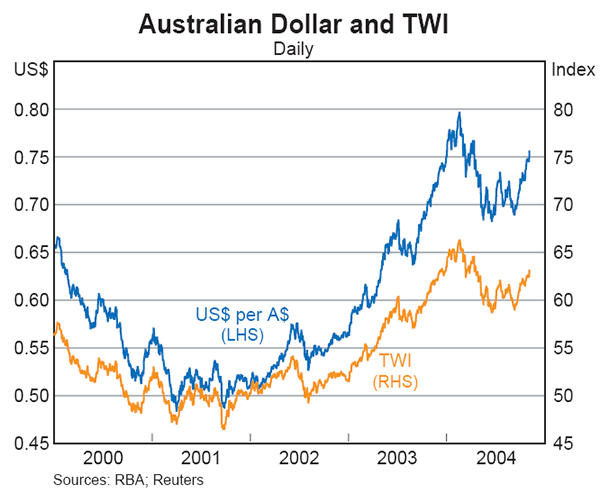
| Over past year |
Since last Statement |
|
|---|---|---|
| Philippine peso | 9.3 | 8.6 |
| US dollar | 7.4 | 7.7 |
| PNG kina | 1.2 | 6.5 |
| Indonesian rupiah | 15.2 | 6.3 |
| UK pound | −1.5 | 6.1 |
| Taiwan dollar | 5.7 | 5.4 |
| South African rand | −5.7 | 4.1 |
| Singapore dollar | 3.0 | 4.1 |
| South Korean won | 1.3 | 3.1 |
| Japanese yen | 4.6 | 2.9 |
| European euro | −2.7 | 1.0 |
| Swiss franc | −3.9 | 0.3 |
| New Zealand dollar | −5.1 | 0.3 |
| Swedish krona | −2.6 | −0.5 |
| Canadian dollar | −1.3 | −1.3 |
| TWI | 3.5 | 4.6 |
|
Source: RBA |
||
The strong demand for the Australian dollar over the past couple of years has meant that the Australian dollar/US dollar is now the fourth most traded currency pair globally, according to the latest survey of foreign exchange activity published by the Bank for International Settlements (see Box A).
In line with the recent movements in the exchange rate, market sentiment towards the Australian dollar has become more positive recently, after declining sharply as the exchange rate fell from its peak in mid February. Speculative positioning in Australian dollar futures on the Chicago Futures Exchange has risen significantly to relatively substantial long positions, which are now back at levels last seen in early February (Graph 21). Sentiment in the Australian dollar options market, as indicated by 1-month risk reversals (a measure derived from the relative prices of put and call options in the Australian dollar), has returned to its highest level in around seven months. That is, there is now substantially less probability attached to a near-term depreciation of the Australian dollar than was the case some months ago. Over the past three months, Australian dollar volatility has also fallen back to around its post-float average after rising sharply in the first half of the year.
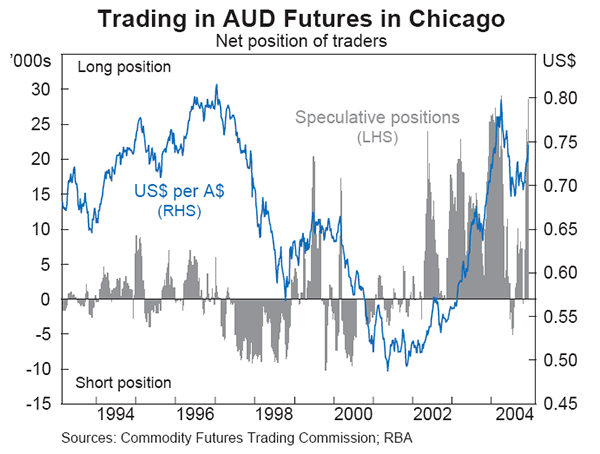
Over the past three months, the Bank's foreign exchange purchases were broadly in line with the amount needed to cover sales of foreign exchange to the Government. As a result, net reserves have remained relatively unchanged at just under $25 billion since the middle of the year. Holdings of foreign exchange under swaps have fluctuated, due to the continuing use of swaps in domestic liquidity management.
Box A: Global Foreign Exchange Turnover
Global foreign exchange market turnover rose sharply in the three years between April 2001 and April 2004.[1] In part this represented a return to more normal rates of activity from a subdued level of trading in 2001. At that time, the US dollar bubble was at its peak, and was associated with a buy-and-hold strategy toward US dollar denominated assets. The search for yield has also boosted general interest in foreign exchange as an asset class for investors, and the Australian dollar has benefited more than others, reflecting the positive yield differential available. Hence while turnover has risen noticeably in all markets and in all currencies, the rise in activity in both the Australian dollar and the Australian market was noticeably stronger than the global average. The valuation effects of the rise in the exchange rate from just under US50 cents in April 2001 to around US75 cents in April 2004 were also important in explaining the increase in turnover reported in US dollar terms.
The AUD/USD is now the fourth most traded currency pair in the world, with trading in the euro/USD the highest, followed by the yen/USD and pound sterling against the US dollar (Graph A1). Average daily global turnover of the Australian dollar against the US dollar has increased from US$47 billion to US$90 billion, which places the currency pair ahead of trading in other major currencies such as the Swiss franc and Canadian dollar against the US dollar. About one-third of this turnover in the Australian dollar occurred in Australia, with the rest spread across the major foreign exchange centres around the globe.
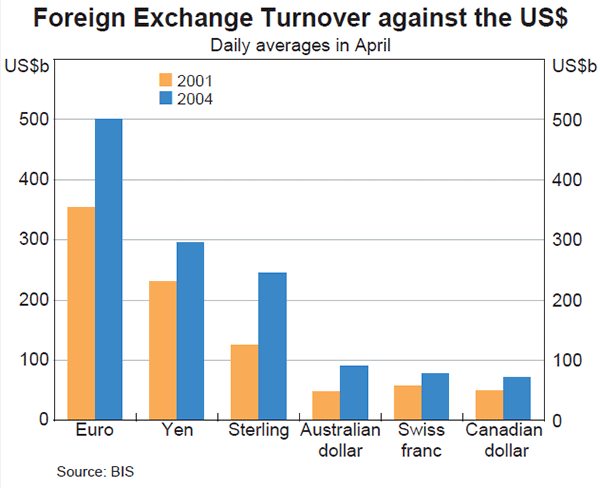
Total foreign exchange turnover in Australia (taking into account not only trading in Australian dollars but also other currencies) also recorded a substantial rise in total turnover in 2004, from US$52 billion per day in 2001 to US$81 billion (Table A1). On these figures the Australian market is the seventh largest in the world and the fourth largest in the Asia-Pacific region.
| Country | 1992 | 1995 | 1998 | 2001 | 2004 |
|---|---|---|---|---|---|
| United Kingdom | 291 | 464 | 637 | 504 | 753 |
| United States | 167 | 244 | 351 | 254 | 461 |
| Japan | 120 | 161 | 136 | 147 | 199 |
| Singapore | 74 | 105 | 139 | 101 | 125 |
| Germany | 55 | 76 | 94 | 88 | 118 |
| Hong Kong SAR | 60 | 90 | 79 | 67 | 102 |
| Australia | 29 | 40 | 47 | 52 | 81 |
| Switzerland | 66 | 87 | 82 | 71 | 79 |
| France | 33 | 58 | 72 | 48 | 64 |
| Canada | 22 | 30 | 37 | 42 | 54 |
|
(a) Adjusted for local inter-dealer double-counting Source: BIS |
|||||
Turnover in the domestic market remains evenly divided between transactions involving the Australian dollar and those that do not. Of note is the increased turnover in trades involving the euro. This is in line with the growing importance of the euro in other major trading centres, and in part reflects that the euro was still a relatively new currency in 2001 but it has since gained more widespread acceptance. A greater commitment to the Australian market from several large European investment banks that trade out of Sydney has also boosted euro turnover in Australia.
Spot transactions in the foreign exchange market have risen by 93 per cent in Australia since the previous survey, while turnover in both forwards and foreign exchange swaps was up by 43 per cent. Transactions between resident dealers and overseas banks were one of the driving forces behind the rise. Anecdotal evidence gathered domestically, and supported by findings of other central banks, suggests that the increased participation of hedge funds may have been a major contributor to the rise in turnover. Hedge funds were increasingly noted as taking speculative positions in foreign exchange in recent years, and were also more active than previously in hedging their currency exposures on underlying investments.
Domestic Economic Conditions
Growth in the Australian economy remains solid, though the expected impetus from the external sector has not yet developed. In the June quarter, GDP grew by 0.6 per cent, with growth over the year above trend at 4.1 per cent, reflecting the very strong quarterly outcomes in the second half of 2003 (Graph 22). Growth in the June quarter was driven by domestic demand, with continued strong consumption spending, a rebound in business investment and a further increase in dwelling investment. Partly offsetting this strength was a much less rapid accumulation of stocks than in the March quarter, and a further fall in net exports as imports rose slightly faster than exports, though the subtraction from growth was only modest. The recovery in the rural sector also appears to have run its course, with farm production falling in the quarter after a run of sizeable contributions to GDP growth.
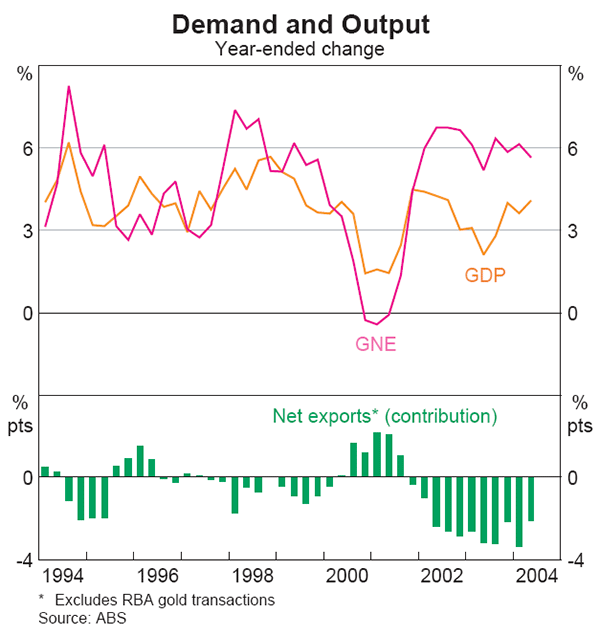
Although forward indicators suggest a slowing in business investment growth and the possibility of modest falls in dwelling investment in the second half of 2004, household consumption is likely to stay firm, with consumer sentiment remaining around record highs and households receiving a substantial boost to their incomes from recent Budget initiatives. A rebalancing of activity between domestic and external sources of demand is also likely to become evident over the year ahead, with net exports expected to be a much smaller drag on growth than in the past few years.
Household sector
The rapid pace of consumer spending over the course of 2003 and early 2004 continued into the June quarter, with household consumption rising by 1.1 per cent to be 6.1 per cent higher over the year; this was the fifth consecutive quarterly rise in excess of 1 per cent. Growth in the June quarter was concentrated in services, with particular strength in spending on transport, health and recreation & culture; growth in spending on goods was more moderate. More recently, in the September quarter, the volume of retail sales increased by 0.9 per cent. Much of the growth occurred late in the quarter, with the value of retail sales rising by 0.8 per cent in September; this followed a pullback in spending in the preceding two months from the spike recorded in June. Retail spending has been especially volatile in recent months, partly reflecting the staggered timing of the government payments to households related to measures announced in the 2004/05 Budget. Spending on motor vehicles rose slightly in the September quarter to a record high (Graph 23).
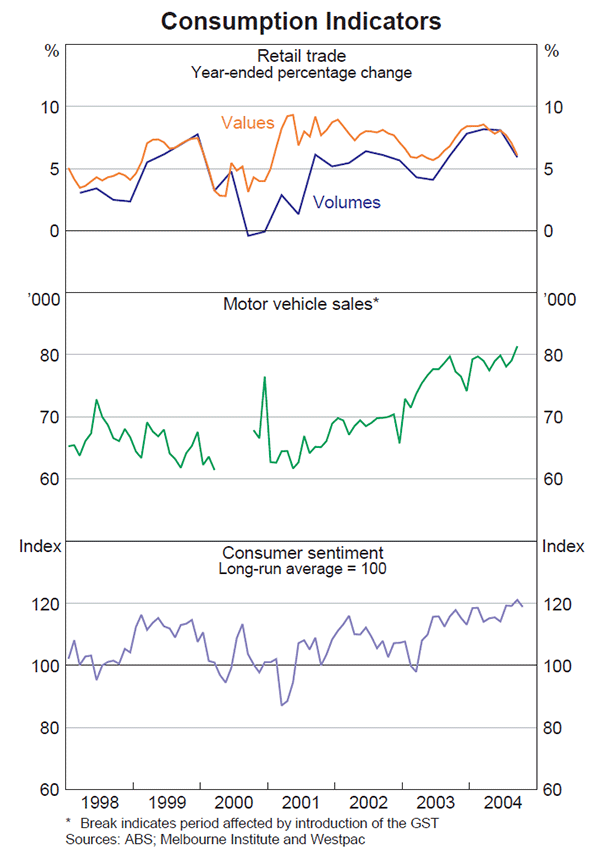
The ongoing strength in consumption is being underpinned by a generally favourable economic environment. Household incomes remain supported by solid employment growth and rising real wages. Earlier strong gains in house prices have increased household wealth significantly since the late 1990s. Households have also received income tax cuts and increased family benefit payments in recent months, with a further cut in income tax to take effect next July. Consistent with these factors, consumer sentiment has remained close to its highest level in 30 years. Nevertheless, the sharply higher fuel prices evident in recent months are likely to contain growth in discretionary expenditure. Furthermore, as wealth effects diminish in line with the easing in house prices since late 2003, households may become more restrained in their spending.
Total household assets have risen at a modest pace during 2004, after increasing significantly in the preceding five years, reflecting the recent moderation in house price growth. However, at the same time, household borrowings have been rising strongly, by around 17 per cent over the past year. With ongoing rises in household debt, the burden of servicing it is now historically high, reaching over 9 per cent of household disposable income in the June quarter (Graph 24). While this ratio was largely unchanged from the March quarter, it is expected to increase further as a consequence of ongoing credit growth. At this stage, though, there is little indication that debt-servicing burdens are affecting household behaviour, with personal bankruptcy rates and housing loan arrears at very low levels.
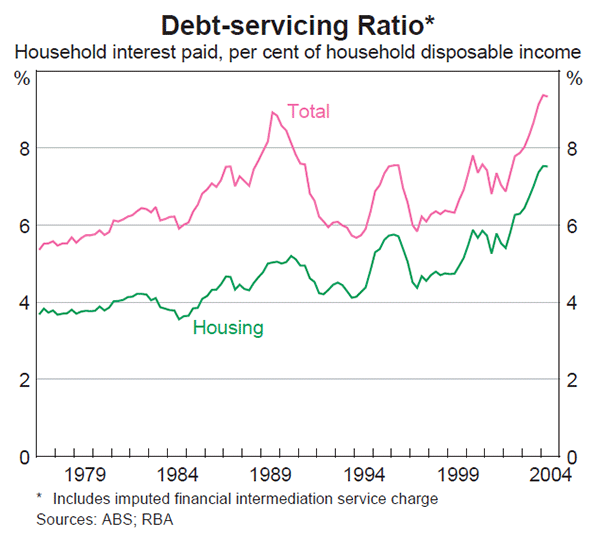
Housing
Activity
Dwelling investment continued to expand over the first half of 2004, though at a much slower pace than during the second half of 2003. It increased by around 1 per cent in the June quarter, to be almost 12 per cent higher over the year, with the increase in the quarter driven by growth in alterations and additions while new dwelling construction was broadly unchanged.
The housing construction sector is operating at close to maximum capacity, with a large stock of outstanding work to be done. However, forward indicators point to an easing in new construction in the period ahead. The downward trend evident in building approvals for houses over the past year has continued in recent months, with house approvals now 13.7 per cent lower than the average in 2003. The volatile medium-density series is still at a high level, but is well below the peaks seen in recent years (Graph 25). Other leading indicators of housing demand, including display home traffic and land sales, remain subdued in most states, and the Housing Industry Association series of commitments to build fell further in September. Despite the recent easing in demand, residential construction activity is expected to remain around current levels for the remainder of 2004, supported by the large amount of work in the pipeline. This is particularly so in the medium-density sector, where many apartments are committed for construction. There are also many apartment projects that have been approved but not yet commenced, though it is not clear whether this reflects delays as a result of capacity constraints or cancellations of building work approved as investors retreat from this market. Housing activity is also likely to be supported by continued high levels of alterations and additions, given the backlog of work and continuing strong demand for renovations.

Financing and prices
After peaking at $15 billion in late 2003, the value of monthly housing loan approvals has been broadly stable during 2004, averaging just above $12 billion per month (Graph 26). This stability has masked divergent trends in loan approvals to owner-occupiers and investors. After declines late last year, approvals to owner-occupiers have since grown, while those to investors have continued to fall. This fall is likely to reflect diminished prospects of capital growth and the recognition of persistently low returns in rental markets.
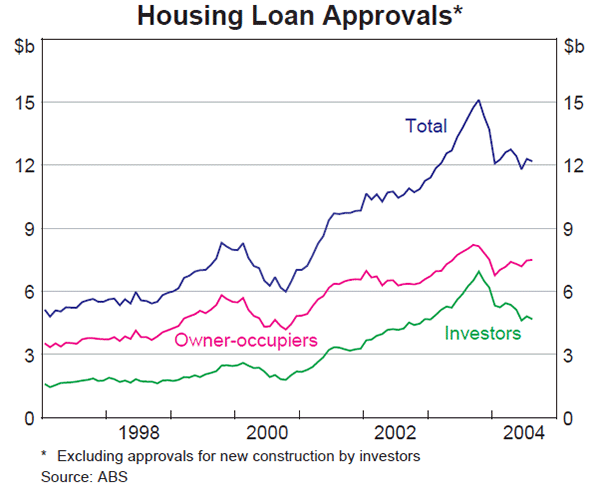
The rate of growth of housing credit has continued to decline during 2004. In September, housing credit increased by 1 per cent following a similar rise in August. On a three-month-ended basis, a pronounced slowing is now apparent, with housing credit expanding at an annual rate of 13 per cent over the latest three months, compared with a peak growth rate of 24 per cent over the three months to November last year. The decline in housing-related credit growth has been larger than expected based on the fall in loan approvals to date, suggesting that, among other things, some combination of a pick-up in repayments and lower usage of mortgage redraw facilities has contributed to the decline.
A reasonable range of information on house prices in the September quarter is now available. As in the March and June quarters, the majority of indicators show that house prices fell in the quarter, and over the year to date (Graph 27 and Table 8).[1] Figures from the Commonwealth Bank of Australia (CBA) (which are based on house purchases funded by the CBA and are not subject to revision) suggest that nationwide house prices fell in the September quarter, with declines in most capitals. Data from the state Real Estate Institutes (REIs) point to moderate falls or broadly unchanged prices in the four capitals for which September quarter data were available at the start of November. Data from land titles offices supplied by Australian Property Monitors (APM) also point to a fall in average nationwide prices for transactions contracted in the September quarter, but these are only early estimates and are subject to upward revision as more transactions are recorded. Data on repeat sales from Residex, also from land titles offices, point to house prices falling slightly in Sydney and Brisbane and rising slightly in Melbourne. Overall, in the March and June quarters, the falls in house prices were concentrated in Sydney and Melbourne. In the September quarter, the falls were more widespread, with other capitals except Adelaide (where prices were broadly flat) also showing falls in prices. In Brisbane, where prices were still rising earlier in the year, all four available measures now show falls in the September quarter. There is less information available for Perth and Canberra, but it also suggests significant falls.

| APM | CBA | REIs | Residex | ||||||||
|---|---|---|---|---|---|---|---|---|---|---|---|
| Sept qtr 2004 |
2004 to date |
Sept qtr 2004 |
2004 to date |
Sept qtr 2004 |
2004 to date |
Sept qtr 2004 |
2004 to date |
||||
| Sydney | −5.0 | −8.4 | −6.4 | −15.0 | na | na | −1.3 | −2.2 | |||
| Melbourne | −10.2 | −15.9 | −3.5 | −11.3 | −1.3 | −1.3 | 1.9 | 1.7 | |||
| Brisbane | −2.8 | 1.0 | −3.7 | −4.4 | −4.4 | −5.7 | −0.4 | 2.0 | |||
| Adelaide | 0.0 | 7.3 | 1.8 | −1.8 | 0.0 | 6.1 | |||||
| Perth | −5.0 | −0.8 | −7.6 | −5.6 | 0.3 | 3.5 | |||||
| Canberra | −8.4 | −7.0 | −10.9 | −10.7 | na | na | |||||
| Australia | −5.7 | −7.4 | −4.8 | −10.4 | na | na | |||||
|
Sources: APM; CBA; REIA and state REIs; Residex |
|||||||||||
Nationwide prices of apartments show a similar pattern of subdued outturns in 2004 following strong growth in 2003 (Graph 28). Estimates of price changes in the September quarter are mixed but point to a continuation of relatively weak market conditions.

Although they represent only a small proportion of total sales, auction results suggest that demand remains subdued in the housing market, despite a modest pick-up in clearance rates from their trough in mid 2004 (Graph 29). Likewise, auction volumes have shown tentative signs of recovery, though in Sydney and Melbourne they remain around half the level recorded in previous years.
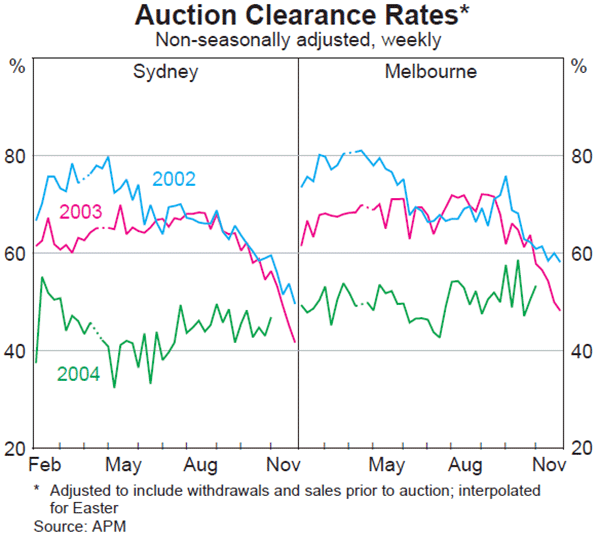
Business sector
Conditions in the business sector overall remain strong. Business sentiment and investment intentions are above historical norms, profitability is at a high level and the global economic expansion is beginning to provide some impetus to growth in trade-exposed industries.
Production in the non-farm economy continued to grow at a solid pace in the June quarter, while farm output fell, with its recovery from the drought-induced trough of 2002/03 now largely complete. In the non-farm economy, domestically oriented industries have maintained their strong growth performance of recent years, supported by continued strength in construction activity, retail trade and a recovery in business services (Graph 30). A pick-up in growth in trade-exposed industries reflects a recent increase in export-oriented manufacturing and transport, while the earlier subtraction from mining has dissipated as temporary disruptions to supply have been resolved. However, surveys suggest that further progress in the rebalancing of growth is likely to occur fairly slowly.
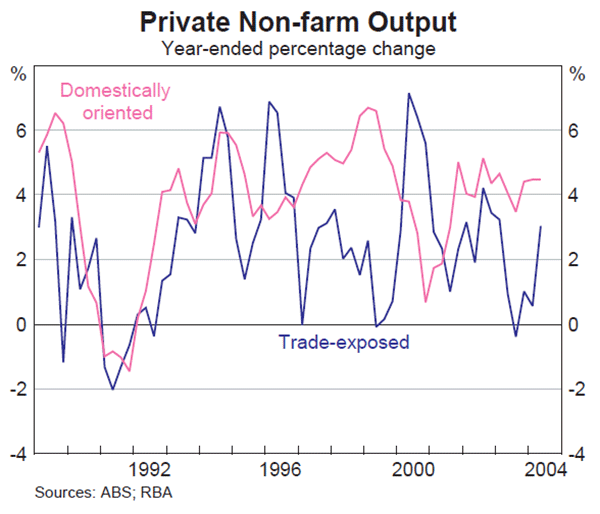
Most business surveys continue to report highly favourable conditions in the non-farm sector, particularly in those industries sensitive to domestic demand. According to the NAB survey, business conditions edged higher in the September quarter to remain well above their long-term average, and close to their highest level in the past decade (Graph 31). Respondents reported high levels of employment, profitability and trading conditions. Capacity utilisation approached the highest levels recorded for this series, while labour availability remained a constraint. In contrast, exports were reportedly relatively subdued, a common theme across a number of surveys, though they have picked up in the September quarter. Looking ahead, businesses expect an export recovery underpinned by strong demand for resources.
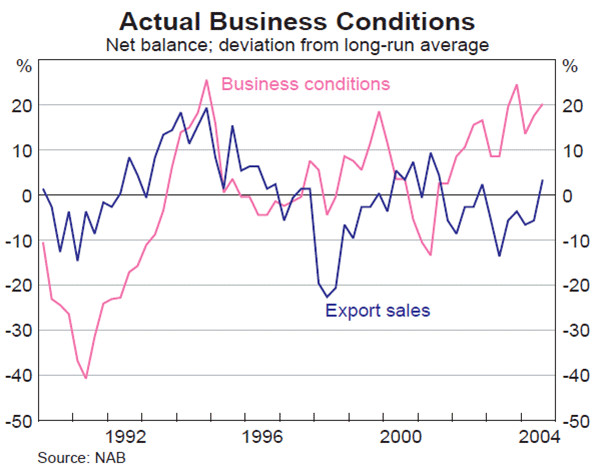
The ACCI-Westpac and the AIG surveys of the manufacturing sector paint a similar picture, with business confidence and most indicators of activity at or above long-run average levels, though in both of these surveys respondents have scaled back their expectations of the likely extent of the export recovery. The Sensis Business Index, which covers small and medium-sized businesses, reported business confidence in trading conditions over the next 12 months at the highest level in the 11-year history of the survey, with high levels of employment, profitability and capital expenditure.
Corporate profitability remains exceptionally high, with the gross operating surplus of private non-financial corporations running at its highest share of GDP in over four decades. Corporate profits grew strongly in the June quarter to be 16½ per cent higher over the year, reflecting a recovery in the profits of some trade-exposed industries, predominantly mining, which has benefited from rising commodity prices and strong world demand. Following a string of strong outturns, profits in the domestically oriented sectors appear to have moderated somewhat in the June quarter, though they remain solid. Profits of unincorporated enterprises fell in the June quarter, but were significantly higher over the year, mainly reflecting developments in the farm sector. Looking forward, both business surveys and equity markets suggest that strong profits growth is expected to persist.
The high level of corporate profitability continues to provide firms with substantial internal funds to pursue their investment plans. In addition, the corporate sector also has access to ample external funding. Over the year to September, business credit grew by 9 per cent and non-intermediated debt increased by 11 per cent, while equity raisings were broadly in line with their average over the past five years.
After contracting in the March quarter 2004, business investment grew by around 4½ per cent in the June quarter, to be 10 per cent higher over the year. The June quarter outcome was driven by a strong rebound in equipment investment. Investment in computer software also increased notably in the quarter, continuing the recovery from a period of weakness, though growth remains slower than recorded during the late 1990s boom. Investment in buildings and structures fell slightly in the June quarter, reflecting a sizeable fall in engineering construction activity (as some major projects were completed), which more than offset a strong rise in non-residential building activity.
The latest capital expenditure (Capex) survey points to solid growth in business investment in 2004/05, underpinned by strong planned expenditure on buildings and structures. Intentions for machinery and equipment investment, adjusted by a five-year average realisation ratio, suggest modest growth in real terms following a period of rapid growth over the past three years. Investment in equipment is expected to be supported by growth in the finance and insurance industry, consistent with the buoyant outlook for the business services sector signalled by surveys of businesses and liaison. Furthermore, the Rabobank survey reports that equipment investment in the farm sector – which is not included in the Capex survey – is likely to be strong over the year ahead at around pre-drought levels.
Other forward-looking indicators also suggest continued near-term strength in non-residential construction (Graph 32). Activity is expected to be supported by the backlog of engineering work yet to be done, with more than two quarters' worth of work still to be completed, and much road and resource-related engineering work scheduled for commencement. However, the near-term outlook for non-residential building is less favourable; while the value of work approved increased by 13.4 per cent in the September quarter, the volume of work approved earlier in 2004 fell well below that recorded in 2003. Moreover, rising construction costs may threaten the viability of some building projects currently in the planning stages.
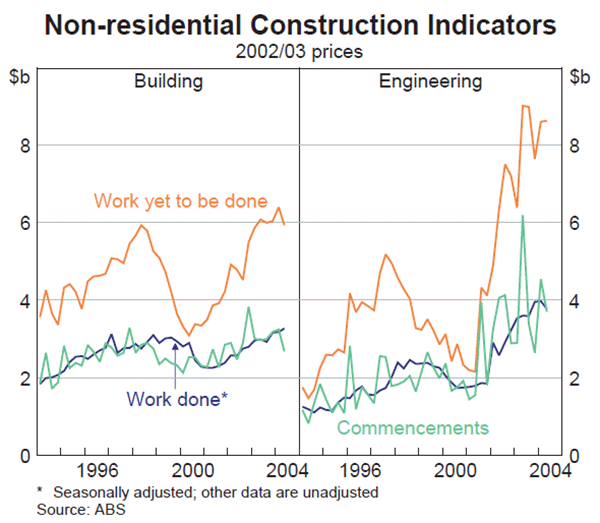
Labour market
Labour market conditions have remained firm in recent months. Employment grew by 2.3 per cent over the year to the September quarter, exceeding the average pace of employment growth for the past decade of 2 per cent. Most of the growth over the year has been in full-time employment, although part-time work also picked up in the quarter (Graph 33). This recent strength follows an apparent lull in employment growth between April and August which the ABS has since partly attributed to sampling problems.
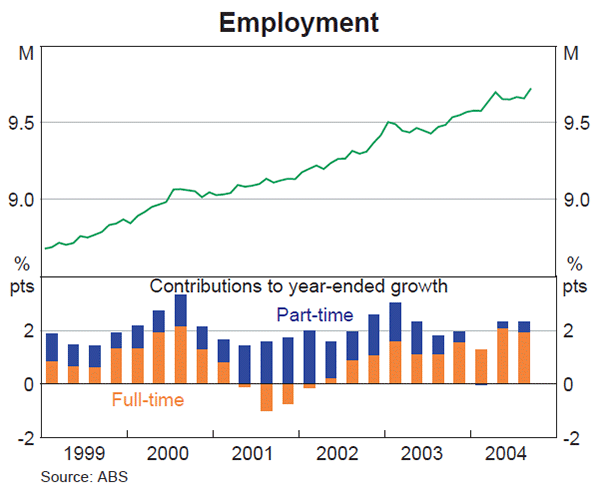
Having declined over most of the past financial year, the unemployment rate has been fairly stable in recent months at a level close to the lows reached in 1981 and 1989 (Graph 34). Broader measures of labour underutilisation have also fallen, though they point to slightly less tightness in the labour market than suggested by the unemployment rate (see Box B: ‘Indicators of Labour Market Tightness’). The participation rate has remained around 63½ per cent over the past few months, consistent with its average of the past few years.
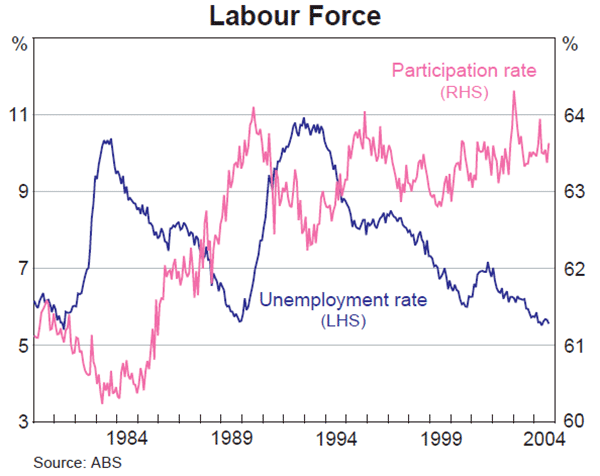
Employment has increased in all states over the year to the September quarter, though outcomes were varied around the country (Table 9). The strongest growth was seen in Queensland, reflecting the rapid expansion in final demand in that state. In contrast, employment growth continues to be subdued in South Australia and below average in New South Wales. Consistent with the expansion of employment, unemployment rates have declined in most states over the past year. Queensland recorded a particularly sharp fall, as did Western Australia, which has an unemployment rate well below that in other parts of the country. Despite solid employment growth over the past year, Victoria's unemployment rate has picked up noticeably. This has been associated with increased labour force participation among both males and females.
| Employment growth | Unemployment rate | ||||
|---|---|---|---|---|---|
| Quarterly | Year-ended | Level | Year-ended change(a) | ||
| NSW | −0.5 | 1.3 | 5.5 | −0.4 | |
| Victoria | 0.5 | 2.5 | 6.0 | 0.4 | |
| Queensland | 1.3 | 4.8 | 5.5 | −1.2 | |
| WA | −1.0 | 2.2 | 4.9 | −1.3 | |
| SA | 0.3 | 0.2 | 6.2 | 0.0 | |
| Tasmania | 1.0 | 3.1 | 6.6 | −0.3 | |
| Australia | 0.2 | 2.3 | 5.6 | −0.4 | |
|
(a) Percentage points Source: ABS |
|||||
Forward-looking indicators of labour demand continue to point to solid employment growth in the near term (Graph 35). The ABS measure of job vacancies has grown strongly over the past year, as have various internet-based vacancy series. And while print-based indicators have remained relatively flat over the past year, recent business surveys suggest that hiring intentions remain well above long-run average levels.
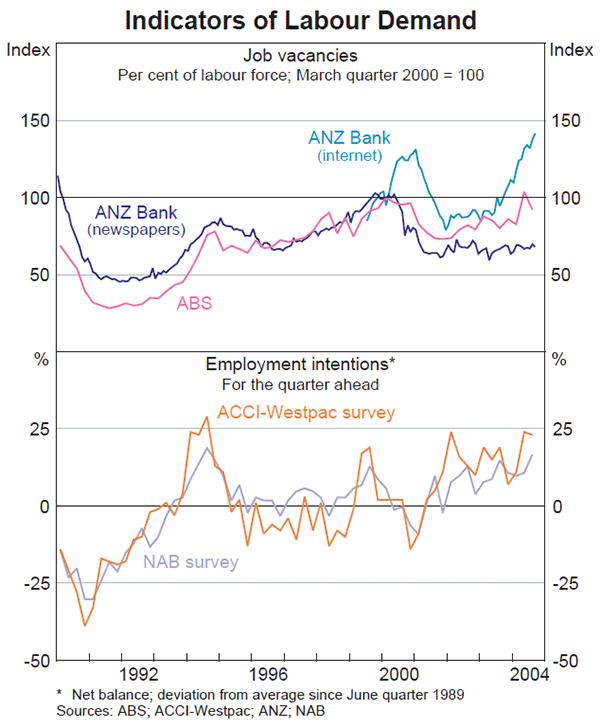
Box B: Indicators of Labour Market Tightness
The strong employment growth of recent years has seen the unemployment rate fall to 5.6 per cent, which is close to the previous lows of the past 25 years. While a low unemployment rate is generally indicative of relatively tight labour market conditions, it is not a definitive measure; labour scarcity will also depend on other factors such as the availability of existing workers to work more hours, the potential for people currently measured as outside the labour force to enter, and the extent of skill matching between the available supply and demand for labour. This box looks at a range of indicators of labour market conditions that take some of these factors into account.
One factor affecting the availability of labour that is not captured by the unemployment rate is the degree of underemployment, which refers to the willingness of employed people (both full-time and part-time) to work more than their current hours. This increased substantially during the early 1990s, with strong growth in part-time workers actively looking for additional work (Graph B1). There is also a significant number of underemployed full-time workers, though these have been more stable as a share of the labour force. Adding these two categories to the unemployment rate would produce a crude measure of underutilisation, but it would tend to be an overestimate because it is likely that an underemployed worker may want only a few extra hours of work each week, while an unemployed person may want full-time work. Instead, it makes sense to calculate an underutilisation measure by weighting each underutilised person by an estimate of the additional hours that they want to work (Graph B2). This measure is close to, but still above its previous cyclical lows, suggesting that the labour market may not currently be quite as tight as implied by the unemployment rate.
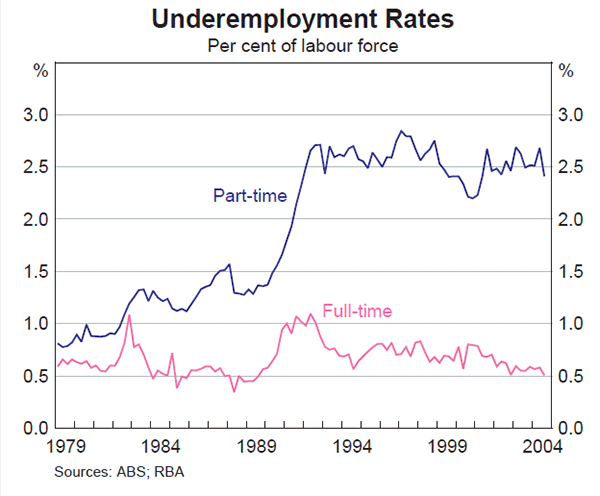
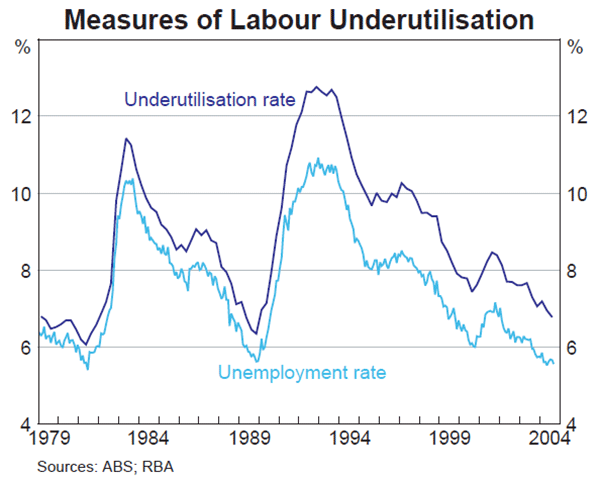
Another source of potential labour supply is the 35–40 per cent of the working-age population which is not measured as being in the labour force. Some proportion of these people report that they are willing to work but are not actively searching for work or are not available to start work immediately, and are known as ‘marginally attached workers’. Data from the Australian Bureau of Statistics suggest that marginally attached workers have increased as a proportion of the working-age population outside the labour force over the 1980s and early 1990s, and currently represent more than 20 per cent of this group. This increase has been associated with a trend decline in the participation of males.[1]
It is not possible to predict how far the unemployment rate might be able to fall before tightness in the labour market leads to significantly stronger economy-wide wage pressures. For a number of reasons, it is possible that wage pressures are now lower at any given unemployment rate than they would have been in the past. First, there is the rise in underutilisation and marginally attached workers discussed above. Second, industrial relations reforms since the late 1980s have resulted in more decentralised wage-setting arrangements, limiting the extent to which wage pressures emerging in areas facing relatively tight labour market conditions are transmitted to other parts of the economy. A third, and reinforcing development is the trend towards longer-duration wage contracts, reflecting the anchoring of inflation expectations at a low level.
Nevertheless, business surveys suggest that a broad range of firms are finding it increasingly difficult to find suitable labour (Graph B3). These survey-based indicators are likely to be influenced both by the overall quantity of labour supply and the extent to which the skills of available workers match the needs of employers. Both the NAB and ACCI-Westpac surveys suggest that the difficulty in obtaining suitable labour has moved into the upper end of the range recorded over the past two decades.
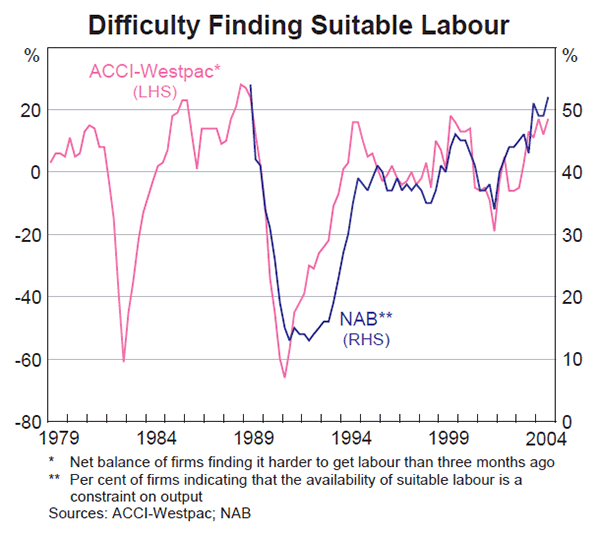
Balance of Payments
The current account deficit has been broadly unchanged over the past year and a half, as a sharp rise in the terms of trade has been accompanied by strong growth in import volumes and only a modest recovery in export volumes. More recently, growth in imports appears to have moderated from the unsustainable pace seen around the start of the year, while the expansion in export volumes has remained weaker than might have been expected given the pick-up in global demand and in world commodity prices since mid last year (Graph 36). The trade deficit in the September quarter 2004 is estimated at around 3 per cent of GDP, while the current account deficit is likely to have remained around the 6 per cent of GDP range that has prevailed in recent quarters (Graph 37).
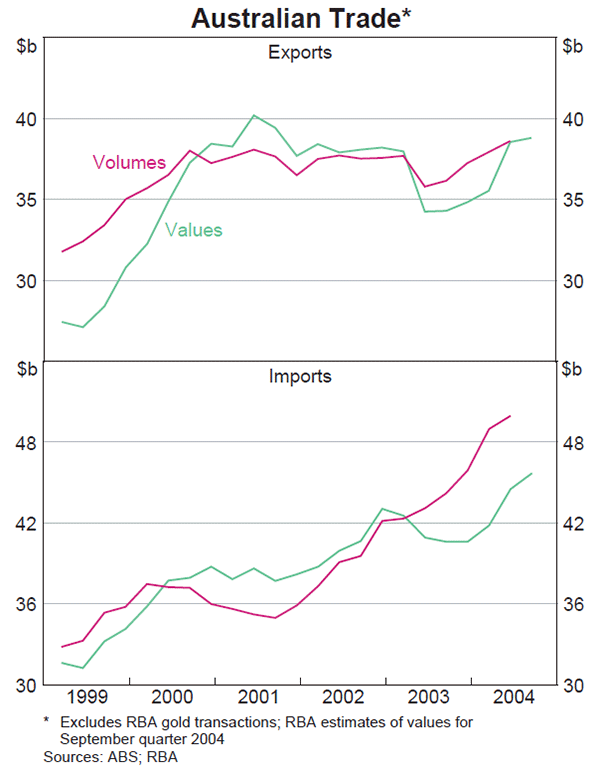
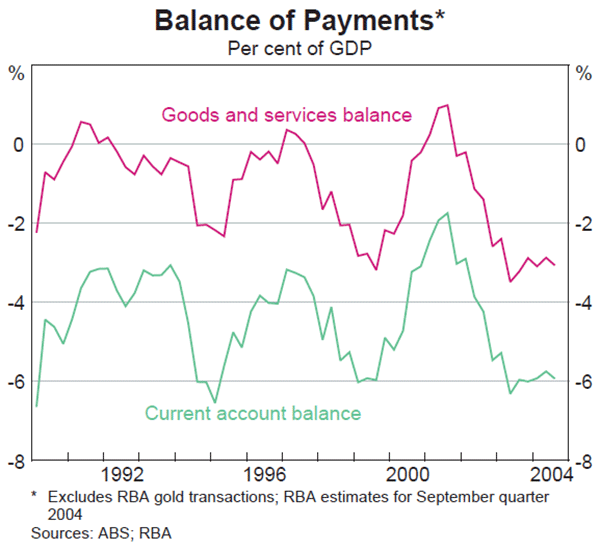
Exports
Export earnings have increased over the past year by around 14 per cent, driven by rising export prices and a recovery in rural and services export volumes (Graph 38). Export earnings increased slightly in the September quarter. With a modest depreciation of the Australian dollar and higher world commodity prices in the September quarter, export prices rose significantly, suggesting that volumes fell in the quarter.
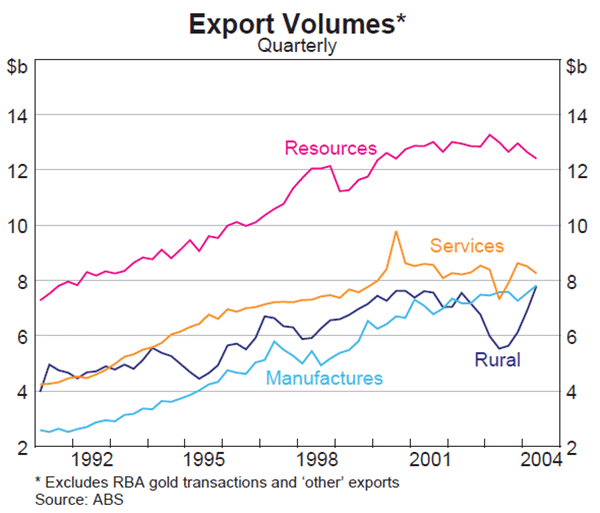
The value of rural exports has increased strongly from the trough associated with the drought, rising by around 34 per cent over the year to the September quarter. This increase has been mostly driven by a rise in volumes, particularly of cereals, following the record 2003/04 winter crop. However, it appears that the recovery in rural exports has largely run its course, with a fall in value terms in the September quarter together with an increase in prices, implying a quarterly fall in export volumes. Looking ahead, the Australian Bureau of Agricultural and Resource Economics (ABARE) expects the current winter crop to be lower than in 2003/04, but still above average levels. Some downside risk to this forecast remains because spring rainfall has been insufficient in some areas. ABARE expects that herd rebuilding will restrain growth in beef production and exports, while the volume of exports of other livestock-based products is expected to expand modestly. The chance of an El Niño event re-emerging remains a downside risk to rural production over the coming year. According to the Bureau of Meteorology, the situation remains ‘delicately balanced’ with some, but not all, indicators at levels characteristic of an El Niño event.
The value of resource exports has risen sharply over the past year or so, and continued to rise solidly in the September quarter, but this was entirely a price effect owing to strength in commodity prices, even when measured in Australian dollars. The weakness in export volumes continues a trend that has been apparent over the past few years, reflecting supply disruptions and capacity constraints, especially for mineral fuels and coal. Nevertheless, as was discussed in the previous Statement, the outlook for growth of resource exports over the next year or two is positive, given that liaison continues to indicate strong external demand for resources. The completion of a number of mineral and energy projects and infrastructure expansions is also expected to boost production and transport capacity. These include the 4th LNG production train at the North-West Shelf and recently commissioned oil fields in the Pilbara region and the Timor Sea. The resumption of production at the Moomba plant is also likely to contribute to a moderate rise in oil exports.
After picking up strongly in the first half of 2004, the value of manufactured exports declined by around 2 per cent in the September quarter, to be broadly unchanged over the past year. Export volumes also appear to have fallen in the quarter, since trade price data suggest that the prices received for manufactures rose. Growth in manufactured exports continues to lag the pick-up in activity among our trading partners. According to the AIG Survey of Manufacturing and liaison with firms, this appears to reflect strong competition in export markets and a loss of competitiveness over recent years owing to the appreciation of the Australian dollar since 2001. In addition, some firms are likely to have been directing production towards the domestic market given the strength of domestic demand. There is nonetheless a positive outlook for manufactured exports with strong trading partner growth and the exchange rate down from its peak near the start of 2004, though growth is likely to be more moderate than during the 1990s.
The value of services exports grew by about 1 per cent in the September quarter and is at a relatively high level, in line with recent strength in short-term visitor arrivals. The outlook for services exports is favourable, supported by the ongoing global economic upswing, and tourism industry contacts remain positive about prospects for the period ahead.
Imports
Growth in import volumes has moderated over recent quarters, following a strong expansion over the second half of 2003, and a surge in the March quarter 2004 that saw annual growth in import volumes of 16 per cent (Graph 36). The earlier strength in imports was broadly based across all categories of goods and services, and was driven by robust growth in domestic demand and low import prices flowing from the appreciation of the Australian dollar in 2002 and 2003. However, the growth of imports slowed in the June quarter and appears to have moderated further in the September quarter. The value of imports rose by 2¾ per cent in the September quarter, with volumes likely to have been broadly unchanged. The recent easing in the pace of growth of import volumes comes after a period when it was unusually high, and is a response to the slowing in domestic demand in the first half of 2004 and the depreciation of the Australian dollar from its February 2004 peak.
Commodity prices and the terms of trade
Commodity prices have continued to increase strongly. The RBA Index of Commodity Prices rose by 2.1 per cent in SDR terms over the three months to October, supported by rising prices of base metals and other resources, and is around 16 per cent higher than a year ago (Graph 39, Table 10). Commodity prices in Australian dollar terms have also increased slightly of late, rising by 0.2 per cent over the past three months, to remain close to the elevated levels seen during 2001–2002.
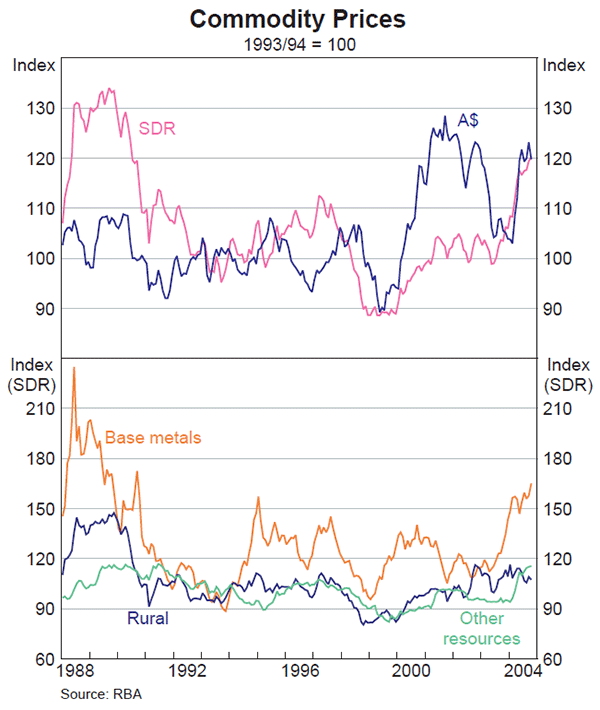
| Three months to October 2004 | Year to October 2004 | |
|---|---|---|
| RBA Index | 2.1 | 16.2 |
| Rural | 0.4 | −1.8 |
| – Wheat | 1.5 | −2.2 |
| – Beef and veal | 7.7 | 10.0 |
| – Wool | −5.4 | −8.7 |
| Base metals | 3.4 | 28.3 |
| – Aluminium | 6.8 | 20.0 |
| – Copper | 6.5 | 51.4 |
| – Nickel | −4.6 | 26.2 |
| Other resources | 2.5 | 23.2 |
| – Coking coal(a) | 3.1 | 23.9 |
| – Steaming coal(a) | 9.3 | 57.0 |
| – Gold | 5.4 | 7.7 |
| Memo item: | ||
| Oil in US$(b) | 30.8 | 75.6 |
|
(a) Latest available data are for September. Sources: ABS; AWB; AWEX; Bloomberg; Meat and Livestock Australia; RBA |
||
Base metals prices increased by 3.4 per cent over the three months to October to reach a new high for the current cycle, although much of the latest increase had been unwound by early November. The pick-up in prices in late September, which was partly attributed to an easing of fears about a pronounced slowdown in China, proved unsustainable, though prices have remained close to recent peaks. Strong global demand has ensured that markets remain tight; reported stocks of aluminium and copper have fallen recently, and copper stocks, in particular, are currently at low levels. The price of copper has also been supported by supply disruptions from strikes in Spain and Chile.
Prices for bulk commodities, particularly for steaming coal, have continued to rise. Steaming coal prices in US dollar terms increased by 9.2 per cent over the three months to September, and are more than 60 per cent higher over 2004 to date, in line with the large contract price increases achieved earlier in the year. Similarly, US-dollar coking coal prices rose by 3.0 per cent over the three months to September, and have risen by close to 33 per cent over the year so far. While spot prices for steaming coal have recently eased from previous highs, they remain well above the contract prices set earlier in the year. Spot prices have been supported by ongoing strength in demand, which bodes well for the forthcoming contract price negotiations for 2005/06.
The strength of world demand has also been a factor helping to drive up oil prices. As discussed in detail in the chapter on ‘International Economic Developments’, US-dollar oil prices have risen by around 75 per cent over the past year. This is likely to put upward pressure on other energy prices that are in the RBA Index. Similarly, the price of gold has risen over the past three months, driven partly by the recent gains in oil prices and the decline in the value of the US dollar against the euro.
Movements in rural commodity prices have been more mixed over the past three months, as higher beef and sugar prices have been largely offset by lower prices for barley, cotton and wool. Beef prices have remained high as a result of ongoing strong demand in the US and the BSE-related ban on imports of US beef into Japan, though these restrictions have eased recently. In contrast, barley and cotton prices have fallen as a result of improving prospects for sizeable expansions in global production.
The ongoing strength in commodity prices, particularly for coal, has continued to support Australia's terms of trade. After an increase in the terms of trade to the highest level in almost 30 years in the June quarter, the terms of trade are estimated to have increased further in the September quarter (Graph 40).
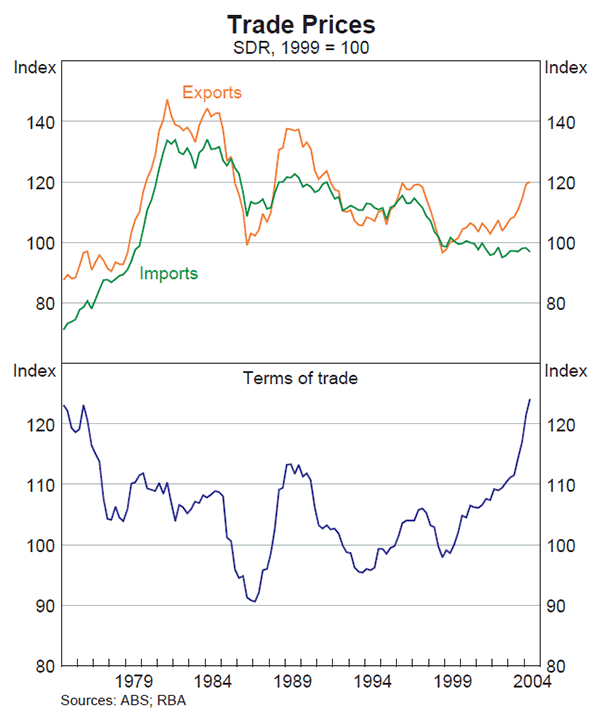
Domestic Financial Markets
Interest rates and equity prices
Money and bond yields
Long-term bond yields have fallen since the time of the previous Statement. Yields on 10-year government bonds are now around 5.4 per cent, about 30 basis points below levels in early August and around 65 basis points below their recent peak in mid June. Yields on 10-year inflation-linked bonds have fallen by a similar amount and, at 2.8 per cent, are close to their lowest recorded levels (Graph 41).

While long-term yields have been affected by domestic news at times, the main factor behind their fall has been developments in overseas bond markets. Concern that rising oil prices may dampen the global recovery appears to have weighed on US yields which, in turn, have led local yields lower. With longer-term yields moving broadly in line with those in the US since early August, the spread between Australian and US 10-year yields has moved in a fairly narrow range around 130 basis points.
The recent falls in bond yields have seen the spread between yields on 10-year government bonds and the cash rate narrow to 15 basis points, well below its long-run average. Yields on bonds with maturities out to four years are below the cash rate. A yield curve of this shape normally suggests that the market attaches a greater probability to the cash rate falling than rising. While this would be consistent with a view that rising oil prices will cause nominal economic activity to slow significantly, it is at odds with other indicators of cash rate expectations and suggests, to some observers, a degree of speculative overvaluation in the domestic bond market.
A clearer measure of the market's expectations for the cash rate over the next year or so can be gauged from short-dated instruments such as overnight indexed swaps. While these instruments suggest the market has indeed scaled back its expectations of a further tightening of domestic monetary policy, they do not suggest the market expects the cash rate to fall. Rather, the market expects the cash rate to most likely remain at its current level over the next year or so (Graph 42).
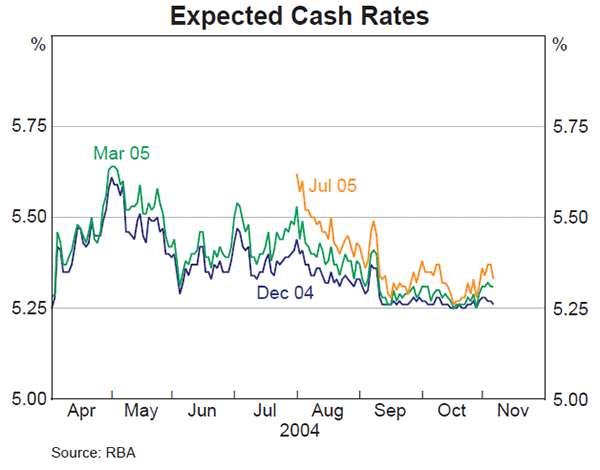
The pricing of credit risk also supports the view that financial markets do not expect a significant slowing in economic activity. Credit risk perceptions, as measured by spreads on corporate bonds and credit default swaps, have changed little over the past few months and remain low by historical standards, indicating that markets see the continuation of favourable trading conditions for corporations.
Intermediaries' interest rates
Intermediaries' variable indicator lending rates have not changed since the last Statement, consistent with there having been no change in the target cash rate. Interest rates on fixed-rate housing and small business loans declined over the same period, in line with a decrease in the cost of funding these loans (Graph 43). As is typical, fixed rates on small business loans followed the movement in funding costs most closely, with the major banks' average 3-year rate falling by around 25 basis points since early August.

Housing fixed rates, which tend to be adjusted less frequently than the fixed rates on small business loans, have fallen since late September, following a period of around seven months when they were largely unchanged. The major banks' average 3-year fixed housing rate is currently 6.65 per cent, around 30 basis points lower than in the months beforehand and around 40 basis points below the standard variable rate (Table 11 and Graph 44).
| Variable rates – households | Variable rates – business | Fixed rates (3 years) |
|||
|---|---|---|---|---|---|
| Mortgages: | Small business | – Housing | 6.65 | ||
| – Standard variable | 7.05 | Residential security: | – Small business | 7.30 | |
| – Basic housing | 6.50 | – Overdraft | 7.95 | – Swap rate | 5.65 |
| – Mortgage managers | 6.70 | – Term loan | 7.25 | ||
| Personal lending: | Other security: | ||||
| – Residential security | 7.20 | – Overdraft | 8.85 | ||
| – Credit cards | 16.45 | – Term loan | 7.85 | ||
| Large business | |||||
| – Overdraft | 8.85 | ||||
|
Source: RBA |
|||||
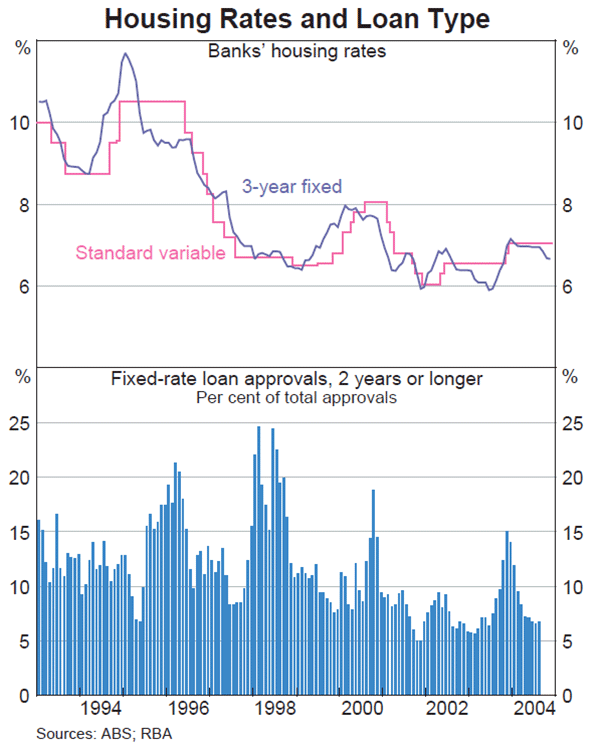
According to the latest available data, demand for fixed-rate housing loans remains relatively low. In the three months to August, the share of new owner-occupier housing loans taken out at fixed rates was steady at around 7 per cent, compared with an average share of 9 per cent over the past five years and a recent peak of 15 per cent a year ago, when monetary policy was being tightened (Graph 44). Use of fixed-rate loans is higher among small businesses but has been in trend decline for a number of years.
Equity prices
Australian share prices have risen by 8 per cent since the last Statement and reached new record highs during the period (Graph 45). The rise in the Australian equity market has been greater than that in most other industrialised countries. It has also been broad-based, although companies in the industrials, consumer staples and, until recently, energy sectors performed most strongly. Price increases in the energy sector were driven by the strength in oil prices, while developments in the other two sectors reflected a combination of strong profit results and acquisitions activity.
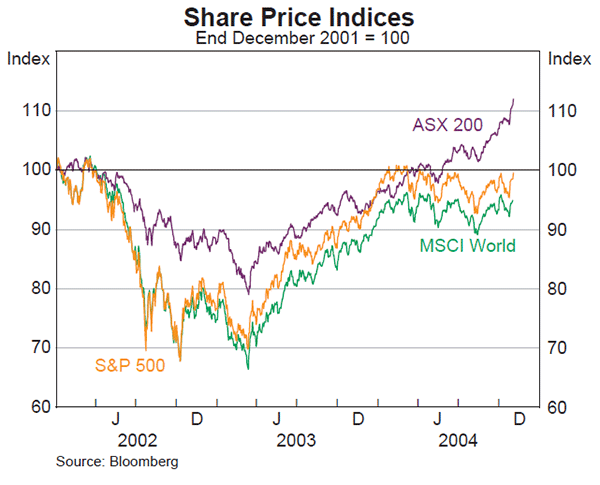
The ASX 200 index is currently 10 per cent above its previous high in March 2002, largely because of the strong performance of the materials and energy sectors over the past couple of years. In contrast, prices in the consumer discretionary, health care, telecoms and IT sectors remain at least 25 per cent below their own record highs (Graph 46).
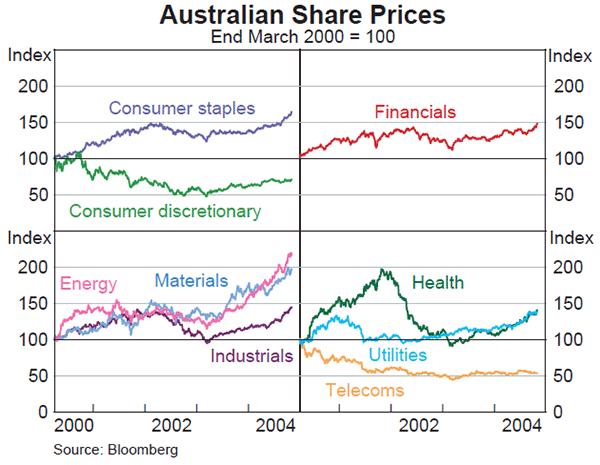
Despite the strong performance of the Australian equity market in recent months, valuation measures have not deteriorated: the price/earnings ratio has fallen over 2004, reflecting the strong results reported for the 2003/04 financial year, and is now only a little above its long-run average; the dividend yield, while down a bit over recent months, remains in line with its average over the past 10 years and compares favourably with the average level of real bond yields in recent years; and equity analysts' earnings forecasts, of around 8 per cent per annum over the next three to five years, are lower than the average of recent years (Graph 47).
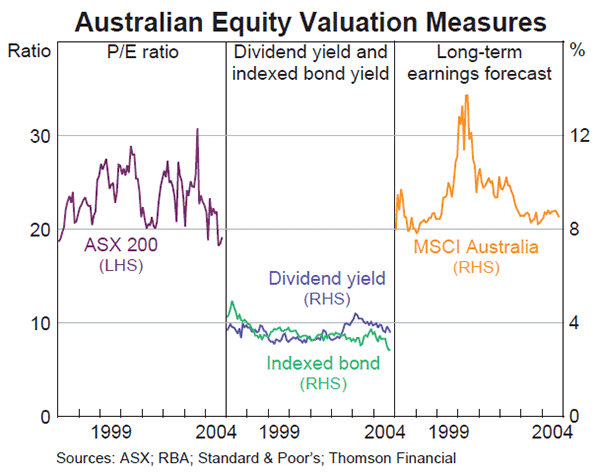
Financing activity
Debt markets
Australian non-government entities issued $40 billion of bonds in the September quarter, continuing the strong issuance seen earlier in 2004. Issuance by financial institutions and asset-backed vehicles was lower in the September quarter, consistent with some moderation in housing credit, but non-financial corporates' issuance, which had been relatively subdued during the first half of 2004, picked up (Table 12).
| Sector | 2002 | 2003 | 2004 | ||
|---|---|---|---|---|---|
| First half |
September quarter |
October | |||
| Bond issues by Australian entities | |||||
| Onshore | |||||
| Financial institutions | 7.4 | 9.8 | 6.5 | 3.8 | 1.0 |
| Non-financial corporates | 7.6 | 4.9 | 1.7 | 2.7 | 1.2 |
| Asset-backed | 19.3 | 21.2 | 13.8 | 7.2 | 1.6 |
| Total | 34.3 | 35.9 | 22.0 | 13.7 | 3.8 |
| Offshore | |||||
| Financial institutions | 31.8 | 49.6 | 38.2 | 15.7 | 4.8 |
| Non-financial corporates | 7.5 | 14.5 | 3.5 | 4.1 | 4.6 |
| Asset-backed | 16.5 | 24.0 | 23.0 | 6.7 | 0.0 |
| Total | 55.9 | 88.0 | 64.6 | 26.5 | 9.4 |
| Total | 90.2 | 123.9 | 86.7 | 40.2 | 13.2 |
| A$ issues by non-resident entities | |||||
| Onshore | 3.1 | 7.1 | 13.3 | 2.7 | 2.7 |
| Offshore | 17.3 | 24.4 | 10.3 | 6.0 | 2.2 |
| Total | 20.4 | 31.5 | 23.6 | 8.7 | 5.0 |
|
Source: RBA |
|||||
In both domestic and offshore markets, Australian entities' gross bond issuance in 2004 has already exceeded that seen in previous full years (Graph 48). Factors behind this strength include both the need to fund the strong growth in household credit, notwithstanding its recent moderation, and strong demand by investors for bonds, especially in light of continued tightness in government debt markets.

Non-resident issuers have also issued more Australian dollar bonds in the first 10 months of 2004 than in any previous year, prompted by demand for higher-quality bonds and favourable basis swap spreads.
As well as record issuance, 2004 has seen further signs of deepening of the domestic bond market. The past quarter has seen a broader range of issuers come to the market and a greater ability to issue in larger amounts or for longer maturities. The broadening in the range of issuers reflects in part the prospective change to the composition of the major bond indexes against which many funds managers benchmark themselves, to include BBB-rated bonds for the first time.
Hybrid securities
Issuance of hybrid securities (instruments with features of both equities and debt) has increased recently, with $2.9 billion of such securities issued since the previous Statement. The type of securities being issued has changed in recent months, with new issues being predominantly perpetual securities that contain conversion options for the issuers and a higher interest rate if the option is not exercised. Previously, the securities often contained conversion options for the investor as well as the issuer. The change appears to have been precipitated by the forthcoming adoption of international accounting standards, which have more restrictions on the type of securities that can be classified as equity and hence qualify as Tier 1 capital.
Equity raisings
Net equity raisings totalled $4.2 billion in the September quarter, roughly in line with the quarterly average since the start of 2000. Although a higher-than-average number of companies listed in the September quarter, the amount of capital raised through IPOs ($1.2 billion) was only in line with its quarterly average for the past couple of years (Graph 49). Listings by companies in the materials and energy sectors accounted for almost 40 per cent of the total number of listings. Other (gross) equity raisings totalled $4 billion, and was dominated by NAB's $1.2 billion dividend reinvestment plan. Buyback activity was weak in the September quarter, but is expected to increase in the December quarter following announcements of large off-market buybacks by BHP Billiton and Telstra.
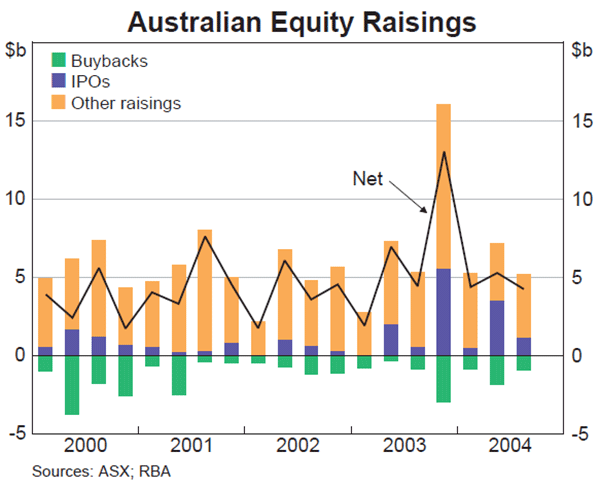
Financial Conditions
Financial conditions continue to be accommodative of domestic economic growth. The cash rate has remained at 5.25 per cent since December last year, a level slightly below its average over the past decade. Credit growth, while having eased back from its very rapid pace of late last year, remains strong. On balance, most other financial indicators also suggest that financial conditions remain supportive for both the household and business sectors.
Total credit increased at an annualised rate of 14 per cent over the six months to September 2004 (Table 13 and Graph 50). While this rate of growth is down from the brisk pace of late 2003, it is still above the average of recent years. The slowing has been attributable to a slowing in household credit, which has been partly offset by stronger business credit.
| Six-month-annualised | Year-ended September 2004 |
||
|---|---|---|---|
| December 2003 | September 2004 | ||
| Total credit | 17.1 | 13.6 | 13.8 |
| Household | 21.3 | 14.4 | 16.9 |
| – Housing | 22.5 | 14.9 | 17.7 |
| – Personal | 15.4 | 12.1 | 12.8 |
| Business | 10.4 | 12.3 | 8.7 |
| Broad money | 14.5 | 7.0 | 9.1 |
|
Source: RBA |
|||
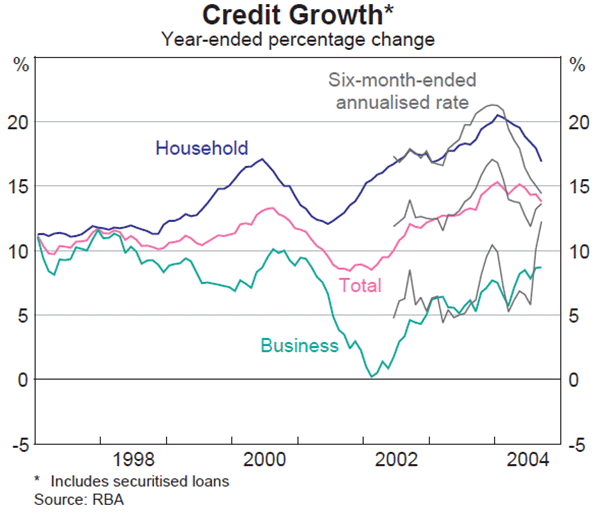
While the growth of household credit continues to decline, it remains high at an annualised rate of 14 per cent over the six months to September. Most of this decline is accounted for by a fall in housing credit growth which, at an annualised rate of 15 per cent over the six months to September, is some 8 percentage points below the peak reached in December last year. The fall in terms of three-month-ended growth rates is somewhat larger, reflecting both the very high monthly growth rates at the end of 2003 and declining growth rates during 2004 (see the chapter on ‘Domestic Economic Conditions’ for further discussion). Growth in personal credit for purposes other than housing has also slowed from its recent peak, though the moderation is not as marked as it is for housing.
The decline in the growth of housing credit over the year reflects a significant drop in housing loan approvals from the peak reached in late 2003, with much of the fall occurring over the turn of the year. Since then, loan approvals for investment properties have continued to fall, while loan approvals for owner-occupied housing have risen. These offsetting influences have resulted in a fairly flat profile for aggregate housing loan approvals in 2004. The most recent loan approvals data appear to be consistent with housing credit growth remaining relatively high in the near term at rates close to those of recent months.
In contrast to the slowing in household credit, the pace of business credit growth has picked up over the course of the past six months. Business credit grew at an annualised rate of around 12 per cent over the six months to September, bringing it above rates seen in late 2003. Business loan approvals are also at a very high level, suggesting that businesses are having little difficulty in obtaining new finance from financial institutions.
Consistent with the unchanged cash rate, household and business variable lending rates have remained unchanged during 2004, at just below their averages of the past decade (Graph 51). As discussed in the ‘Domestic Financial Markets’ chapter, longer-term bond yields have been edging lower, with three, five and 10-year bond yields all falling to levels close to, or even below, the current cash rate. Typically a decline in longer-term yields relative to the cash rate would be interpreted as a sign that monetary policy had become less accommodative. However, in the current situation, developments in foreign bond markets, particularly in the US, appear to have driven longer-term Australian yields lower.
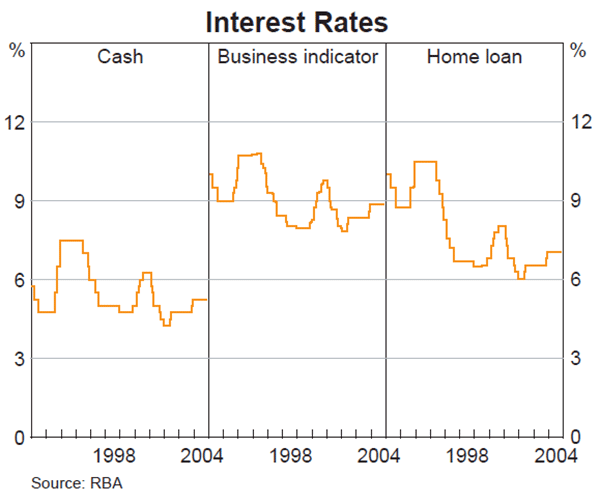
Other indicators of financial conditions suggest that, on balance, monetary policy remains mildly accommodative. The real cash rate is likely to have declined given that measures of inflation expectations have risen while the cash rate has been unchanged over the past few months. In real terms, the trade-weighted exchange rate has risen slightly over recent months, to be about 10 per cent above its average over the post-float period (Graph 52). However, this has been accompanied by further gains in the terms of trade to a level that is about 20 per cent above its post-float average.

Inflation Trends and Prospects
Recent developments in inflation
The Consumer Price Index (CPI) rose by 0.4 per cent in the September quarter to be 2.3 per cent higher over the year (Graph 53). Petrol prices increased by 3.3 per cent in the September quarter and by 12 per cent over the year, contributing significantly to CPI inflation. Excluding petrol, the CPI increased by 0.3 per cent in the September quarter. Based on a range of measures, the Bank's assessment is that underlying inflation over the year to September was slightly lower than CPI inflation (Table 14).

| Quarterly | Year-ended | ||||
|---|---|---|---|---|---|
| June quarter 2004 |
September quarter 2004 |
June quarter 2004 |
September quarter 2004 |
||
| CPI | 0.5 | 0.4 | 2.5 | 2.3 | |
| – CPI (excluding petrol) | 0.2 | 0.3 | 2.1 | 1.9 | |
| – Tradables | 0.2 | −0.1 | 0.5 | 0.7 | |
| – Tradables (excluding petrol and food) |
0.2 | −0.2 | −1.4 | −1.1 | |
| – Non-tradables | 0.7 | 0.9 | 4.1 | 3.6 | |
| Underlying measures | |||||
| Weighted median | 0.6 | 0.5 | 2.3 | 2.2 | |
| Trimmed mean | 0.5 | 0.5 | 2.1 | 2.1 | |
| CPI excluding volatile items(a) | 0.5 | 0.5 | 1.9 | 1.8 | |
|
(a) Volatile items are fruit, vegetables and automotive fuel Sources: ABS; RBA |
|||||
The most noteworthy aspects of inflation outcomes over the past year or so have been the decline in the price of tradable items (excluding food and petrol) following the earlier appreciation of the exchange rate, while non-tradable prices have continued to rise relatively quickly. In the September quarter, the prices of tradable items declined slightly, with further falls in prices of motor vehicles and audio-visual equipment. It appears, however, that the disinflationary impact of the earlier appreciation of the exchange rate is waning, with the rate of decline in tradable prices (excluding food and petrol) moderating in year-ended terms (Graph 54).
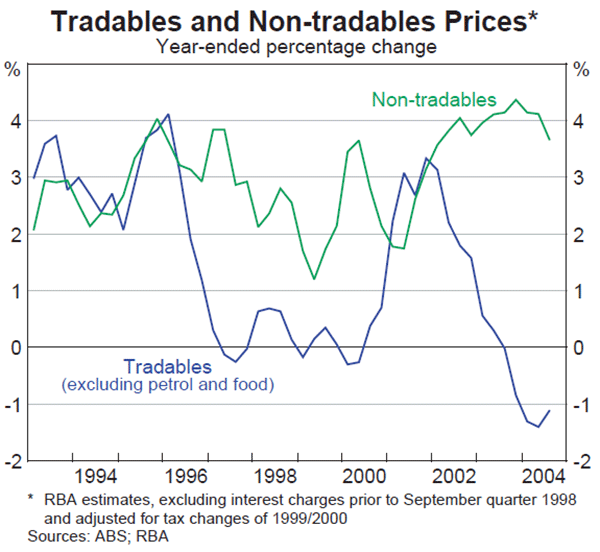
Price rises in a number of non-tradable goods and services have made a sizeable contribution to CPI inflation. Non-tradable inflation was 0.9 per cent in the September quarter, with ongoing pressure in house purchase costs, though these have eased from the very strong rates of a year ago. There were also further strong price rises for a range of administered items such as property rates and utilities. In year-ended terms, non-tradable inflation was 3.6 per cent in the September quarter, down from 4.1 per cent in the June quarter.
Producer prices
Producer price figures for the September quarter suggest that upstream price pressures are building at all stages of production. The prices of outputs from the final stage of domestic production rose strongly in the quarter – underpinned by significant increases in the prices of building construction, utilities and petroleum refining – to be 4.5 per cent higher over the year (Table 15 and Graph 55). Similarly, import prices at the final stage of production recorded a solid rise in the quarter, reflecting the influence of higher oil prices and broad-based increases in the prices of manufactured items. Excluding the effects of oil, the price of outputs from the final stage of production rose by 2.8 per cent over the year. These outcomes for domestic and import prices were consistent with liaison that suggests that the disinflationary impetus from the appreciation of the exchange rate in 2002 and 2003 has abated. For outputs at the earlier stages of production, the effects of large increases in commodity prices, particularly for oil, iron and steel, have resulted in large quarterly increases in prices in the September and June quarters.
| September quarter 2004 |
Year to September quarter 2004 |
|
|---|---|---|
| Preliminary | 2.9 | 4.3 |
| – Domestically produced | 2.4 | 4.1 |
| – Imported | 5.5 | 6.1 |
| – Excluding oil | 2.1 | 2.9 |
| Intermediate | 2.3 | 3.2 |
| – Domestically produced | 2.0 | 3.3 |
| – Imported | 4.3 | 2.2 |
| – Excluding oil | 1.8 | 2.3 |
| Final(a) | 1.4 | 3.2 |
| – Domestically produced | 1.4 | 4.5 |
| – Imported | 1.2 | −3.4 |
| – Excluding oil | 1.3 | 2.8 |
|
(a) Excluding exports Source: ABS |
||
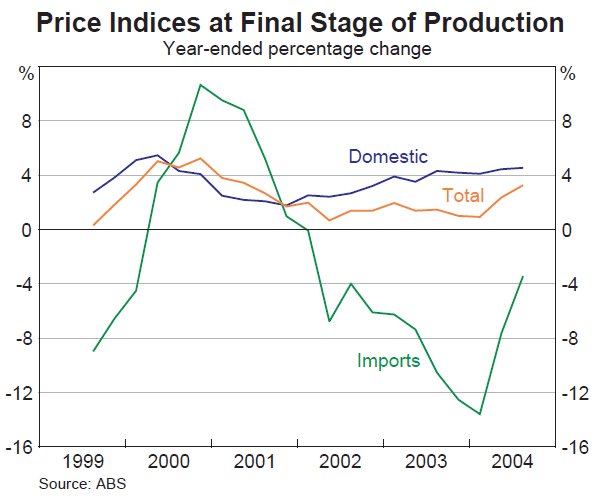
The pick-up in output prices in the September quarter was most evident in the manufacturing and transport & storage sectors, which faced sizeable increases in the costs of raw materials and fuel. While construction output prices rose somewhat less rapidly than in recent quarters, they have risen by more than 7 per cent over the year, reflecting persistent labour cost pressures as well as significant increases in material costs. There have been particularly large increases for steel prices, which are likely to rise further in coming months as major contracts are renewed.
Labour costs
While the demand for labour remains firm, there is little sign at this stage of the emergence of heightened wage pressures across the economy as a whole. The Wage Cost Index (WCI) increased by 0.8 per cent in the June quarter, once again slightly less than expected, to be 3.6 per cent higher than a year earlier (Graph 56). Public-sector wage growth eased somewhat, but was still above that of the private sector, where wages grew by 3.4 per cent over the past year. Stronger wage outcomes were evident in the construction sector, consistent with reports of skills shortages, particularly in non-residential construction.
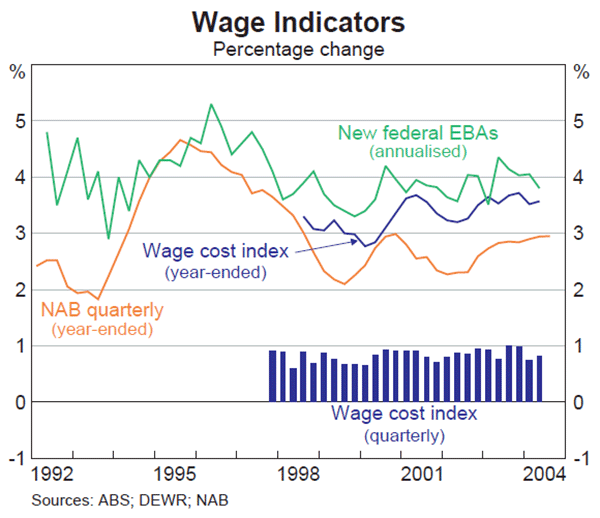
Other indicators also show broadly unchanged wage pressures on an economy-wide basis. The Department of Employment and Workplace Relations reports that the average annualised wage increase certified in new enterprise bargaining agreements fell slightly to 3.8 per cent in the June quarter from 4.1 per cent in the March quarter. There was no change recorded in the average wage increase for the stock of existing agreements, which remained at 3.9 per cent. More timely data from the NAB Quarterly Business Survey suggest that labour costs have continued to build gradually, increasing by 3 per cent over the year to September, while expected labour cost pressures have remained steady. According to the Mercer Quarterly Salary Review, annual growth in the base salaries of executives rose to 4.8 per cent in the year to September, among the higher outcomes of recent years.
While economy-wide measures of wages growth have remained relatively stable, localised pressures are certainly evident in some official wage measures as well as through liaison, which points to substantial increases in wages for skilled employees in the construction and resource sectors, and in some areas of business services. Firms are also reporting strong growth in non-wage labour costs, including sub-contractor payments for self-employed workers, bonus payments to employees, and training for new (and typically less skilled) employees. These developments are consistent with survey data showing that firms are finding it increasingly difficult to attract suitably skilled labour, pointing to the possibility of stronger wage pressures emerging in the period ahead. (See Box B: ‘Indicators of Labour Market Tightness’ for further discussion.)
Inflation expectations
Measures of inflation expectations suggest that most observers expect inflation to rise gradually over the next two years from the moderate levels currently prevailing (Table 16). The Bank's survey of market economists showed that their median forecast for CPI inflation over this financial year was unchanged from last quarter. They continue to expect an increase in inflation over longer horizons, albeit a more modest one than had been anticipated last quarter. Union officials' median expectations of inflation were unchanged; they expect inflation to rise gradually through to mid 2005 before stabilising.
| Year to June 2005 | Year to June 2006 | |||||
|---|---|---|---|---|---|---|
| May 2004 |
August 2004 |
November 2004 |
August 2004 |
November 2004 |
||
| Market economists(a) | 2.5 | 2.4 | 2.4 | 2.7 | 2.5 | |
| Union officials(b) | 2.9 | 3.0 | 3.0 | 3.0 | 3.0 | |
| (a) RBA survey (b) ACIRRT survey |
||||||
The inflation expectations implied by financial market prices have also been broadly unchanged over the past six months. According to the difference between nominal and indexed bond yields, the market expects inflation over the medium term of around 2.6 per cent (Graph 57). However, relative to a year earlier, inflation expectations have shifted moderately higher.
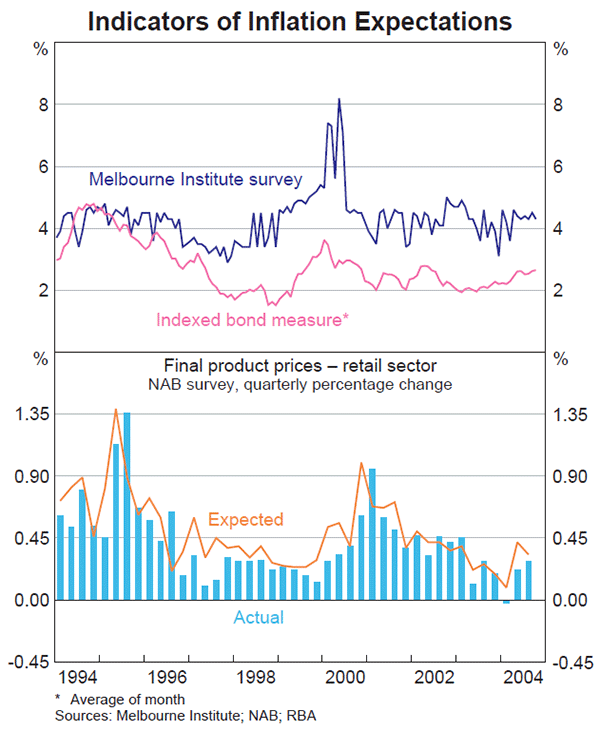
The inflation expectations of consumers have been relatively stable despite significant increases in oil prices and the consequent rises in petrol prices. The Melbourne Institute survey reported that the median expectation for consumer price inflation in October remained close to its average level of the past six months. There has, however, been some pick-up in the inflation expectations of businesses. The NAB survey reported that the pace of economy-wide and retail product price inflation rose in the September quarter and is expected to remain around current levels in the December quarter. Similar outcomes are apparent in the quarterly AIG survey of manufacturers.
Inflation outlook
CPI inflation of 2.3 per cent over the year to the September quarter was down marginally from the previous quarter, with most underlying measures running slightly below the headline rate. Over the past couple of years, the trend in underlying inflation has been one of gradual decline, reflecting the impact of the exchange rate appreciation that took place during 2002 and 2003. However, with this effect now waning, underlying inflation is expected to remain around current levels before rising gradually from early next year to around 2½ per cent towards the end of 2005 and to around 2¾ per cent by mid 2006. While this profile is broadly in line with that presented at the time of the previous Statement, it is noteworthy that the expected trough in inflation is not as low as had been forecast at the beginning of the year, when both headline and underlying measures were forecast to decline to a trough of around 1½ per cent near the end of 2004. This partly reflects the fact that the exchange rate has depreciated since early 2004.
Domestic inflationary risks appear to be tilted somewhat to the upside. Producer price data, business surveys and liaison indicate that upstream inflationary pressures, both from materials and labour costs, are building.
Another important consideration is the outlook for oil prices. The forecasts are based on the assumption that the current level of oil prices will not be maintained and prices will fall to around US$45 per barrel in a year or so, broadly in line with market expectations. The rise to date has had a direct impact on CPI inflation in the September quarter, and it is likely that petrol will make a further significant contribution to CPI inflation in the near term. This is expected to keep year-ended CPI inflation above underlying inflation over the next few quarters, with the two measures converging thereafter. However, if oil prices are sustained at, or rise above, recent high levels, headline CPI inflation would be higher than currently forecast. This could also mean a greater potential for second-round effects, particularly given the strong conditions in labour and product markets. However, to the extent that higher oil prices persist and have a significant dampening impact on the global economy, they would also tend to reduce domestic growth and consequently place some downward pressure on underlying inflation.
Footnote
The Australia-wide figures are weighted averages of prices in capital cities, and have been calculated by the RBA. The weights used are now based on the number of each type of dwelling in each capital city. [1]
Footnotes Box A
Data are sourced from the preliminary results of the BIS ‘Triennial central bank survey of foreign exchange and derivatives market activity in April 2004’ in association with the RBA Media Release No 2004-10, 29 September 2004. [1]
Footnotes Box B
A more detailed discussion of changes in the participation of different age cohorts of males and females can be found in the Reserve Bank of Australia Bulletin, October 2002. [1]